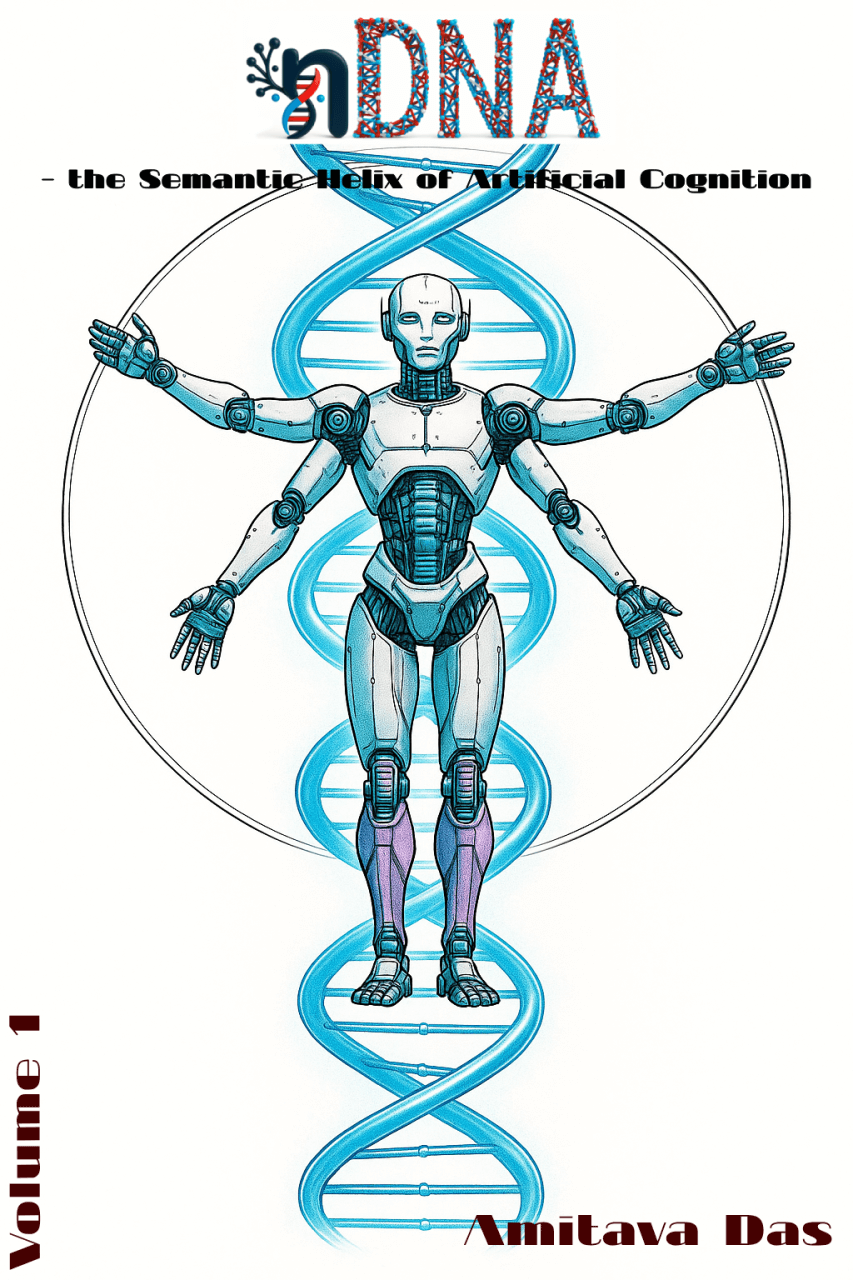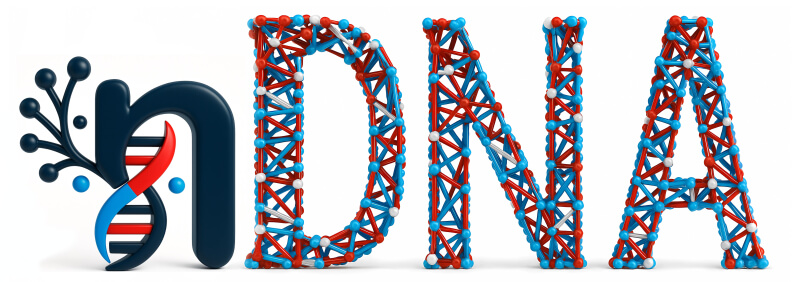 Lens - nDIV: Neural Directional Inheritance Vector
Lens - nDIV: Neural Directional Inheritance Vector
While prior metrics such as nHD, nGDI, and nTDS quantify semantic divergence or trait dominance in foundation models, they fall short of capturing the nuanced phenomenon of inheritance directionality within latent semantic spaces. To fill this conceptual and analytical gap, we introduce the Neural Directional Inheritance Vector (nDIV), a novel metric directly inspired by the well-studied biological principle of directional inheritance or directional selection. This metric is designed to precisely quantify how offspring semantic traits systematically gravitate toward one parent model or the other, revealing latent preferential biases and directional flows within high-dimensional embedding manifolds.
Inspiration
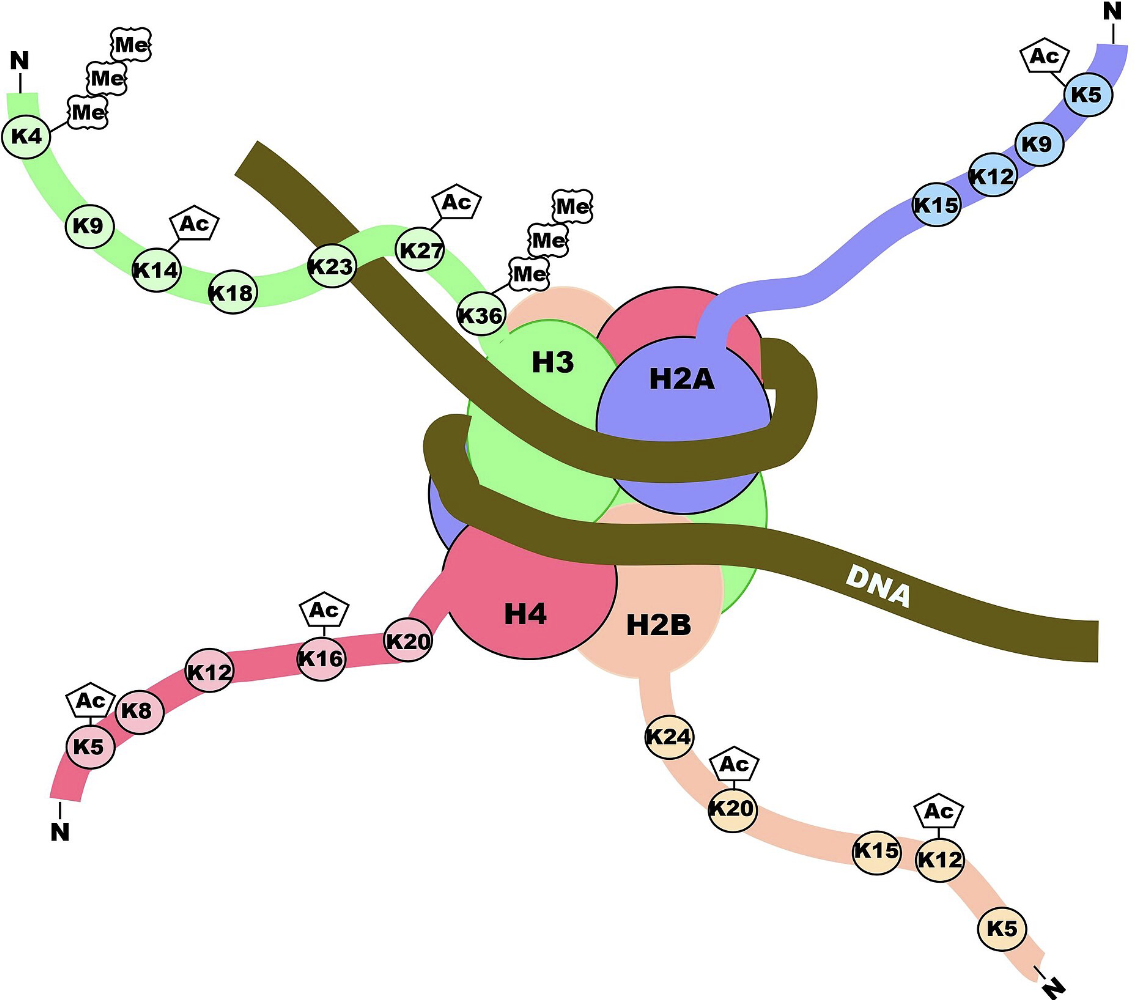
Biological Foundations of Inheritance Directionality
In biological systems, inheritance transcends the simplistic notion of equal genetic transmission from both parents. Instead, it fundamentally encompasses the directionality of gene expression and regulatory influences that modulate which traits are preferentially propagated, suppressed, or transformed across generations. This directional inheritance manifests as the selective amplification or silencing of gene expression patterns, shaped by evolutionary forces such as natural selection, as well as by complex epigenetic modifications and developmental gene regulatory networks([5];[6]).
The figure above provides a canonical illustration of these processes, showing how chemical modifications like acetylation and methylation of histone proteins dynamically regulate gene accessibility, thereby guiding transcriptional activity in a highly directional manner. These modifications represent vectorial regulatory signals that influence gene expression trajectories, embedding directionality into phenotypic outcomes. Importantly, these epigenetic marks can be heritable, encoding regulatory memory that biases progeny development toward particular phenotypic fates, allowing organisms to adaptively respond to environmental pressures and developmental needs([3];[4]).
Put simply, although offspring inherit genetic material from both parents, the functional expression of these genes is often highly biased. Some genes are amplified to promote beneficial traits, others are silenced to suppress deleterious or redundant functions, and yet others interact through nonlinear regulatory cascades to produce emergent phenotypes not directly predictable from parental genotypes alone[7]. This directional bias is critical for evolutionary adaptability, enabling organisms to dynamically tailor inherited traits in response to fluctuating environments and developmental contexts.
Bridging Biology and Neural Networks
Translating this profound biological concept into the domain of artificial neural networks, particularly large-scale foundation models, we recognize that latent semantic embeddings at each transformer layer encode the model’s internal conceptual landscape, shaped by diverse training data and fine-tuning processes. Analogous to gene expression vectors modulated by epigenetic signals, these latent embeddings exhibit directional flows during model fusion or adaptation, reflecting preferential inheritance of semantic traits from one parent or the other.
This directional inheritance in neural models is neither uniform nor symmetric; rather, it is anisotropic and modulated by the training regimes, data distributions, and alignment objectives, producing epigenetic-like biases within the high-dimensional semantic manifold. Thus, just as biological progeny show biased phenotypic expression beyond genetic sequence alone, offspring models inherit directionally biased semantic trajectories that reveal the complex interplay of their parental origins.
Understanding and quantifying this directional bias is essential for diagnosing model behavior and guiding alignment engineering. The Neural Directional Inheritance Vector (nDIV) formalizes this concept by measuring the vectorial displacement of offspring embeddings relative to the semantic midpoint of their parents, thereby capturing both the magnitude and sign of preferential semantic drift.
In subsequent sections, we present the rigorous mathematical formalism underpinning nDIV, grounded in the biological principles and enriched by modern geometric and information-theoretic insights. This framework empowers precise diagnosis and intervention in complex cultural model fusion scenarios, fostering the development of equitable, interpretable, and culturally coherent AI systems.
Implications for Neural Networks and Foundation Models
Mapping this concept onto artificial neural networks, especially large foundation models, inheritance directionality captures how semantic features from multiple pretrained or fine-tuned parent models are not simply averaged, but instead flow preferentially along particular directions within the high-dimensional latent semantic manifold.
When multiple culturally or linguistically distinct models are merged–via techniques such as parameter interpolation, latent embedding fusion, or knowledge distillation–the resultant offspring model inherits a complex blend of semantic traits. Yet, the relative weighting and directional influence of these inherited semantic components varies across latent dimensions and layers. Certain cultural priors dominate specific semantic directions, while others are attenuated or modulated, creating an anisotropic, directionally biased semantic landscape[8].
Understanding this directional bias is crucial for diagnosing internal model geometry. Unlike scalar divergence or trait dominance metrics, nDIV explicitly captures the vectorial nature of inheritance, revealing which parent’s semantic characteristics drive particular latent regions and how these influences evolve through the network’s depth.
Moreover, this framework embodies epistemic selection, akin to evolutionary pressures, where training regimes, data distributions, and alignment objectives induce selective reinforcement of semantic features. The resulting vector fields in latent space encode both the magnitude and direction of semantic drift inherited from each parent model.
By quantifying this directional semantic flow, the Neural Directional Inheritance Vector (nDIV) provides a mathematically rigorous and practically valuable tool to:
- Diagnose latent semantic biases favoring one parent culture or domain over another,
- Detect emergent hybrid semantics arising from nonlinear interactions between parental priors,
- Guide targeted semantic interventions for balanced, culturally coherent, and interpretable AI behavior.
Thus, nDIV operationalizes a biologically grounded notion of directional inheritance within foundation models, advancing our capacity to understand and engineer complex cross-cultural semantic integration.
Mathematical Formalism
The concept of directional inheritance in biological systems arises from a sophisticated interplay of genetic, epigenetic, and regulatory dynamics that govern how phenotypic traits are not merely transmitted but modulated and expressed across generations([6]; [7]). Unlike naive Mendelian inheritance, where alleles are passed down uniformly, directional inheritance encodes biased propagation of gene expression patterns shaped by natural selection, epigenetic modifications, and developmental canalization([1]; [4]). This biological framework reveals that progeny phenotypes emerge as vectorial flows in an abstract trait space, modulated by regulatory networks and environmental pressures.
Formally, consider a high-dimensional phenotypic trait space where a genetic expression vector
\[\mathbf{g} \in \mathbb{R}^d\]encodes gene expression levels or regulatory signals. The inheritance directionality can be described by a vector field
\[\mathbf{v}(\mathbf{g}) : \mathbb{R}^d \to \mathbb{R}^d,\]which governs how gene expression trajectories evolve through developmental time or generations([3]; [4]). This directional bias manifests as $\mathbf{v}(\mathbf{g})$ aligning preferentially along axes corresponding to selective regulatory motifs or epigenetic marks[6].
Transposing this rich biological metaphor into the domain of large-scale foundation models, we replace genetic information with latent semantic embeddings
\[\mathbf{x}_\ell \in \mathbb{R}^d,\]at transformer layer $\ell$, capturing the model’s internal conceptual landscape shaped by training corpora and fine-tuning procedures. The index $\ell$ represents the depth in the network, correlating with increasing semantic abstraction([9]; [10]). This defines a latent semantic manifold $\mathcal{M}_\ell$, analogous to phenotypic space, wherein semantic traits are inherited during model fusion or adaptation.
Latent Semantic Embeddings
Consider latent embeddings of two parent models $M_A, M_B$ and their offspring $M_O$ at transformer layer $\ell$:
\[\mathbf{x}_\ell^{(A)}, \quad \mathbf{x}_\ell^{(B)}, \quad \mathbf{x}_\ell^{(O)} \in \mathbb{R}^d,\]encoding semantic traits as points in a high-dimensional manifold $\mathcal{M}_\ell$.
Midpoint and Displacement Vector
Define the midpoint between parents as
\[\mathbf{m}_\ell := \frac{\mathbf{x}_\ell^{(A)} + \mathbf{x}_\ell^{(B)}}{2}.\]The inheritance displacement vector capturing semantic bias is
\[\mathbf{d}_\ell := \mathbf{x}_\ell^{(O)} - \mathbf{m}_\ell.\]Parental Difference Vector
The principal axis of semantic divergence is
\[\mathbf{p}_\ell := \mathbf{x}_\ell^{(A)} - \mathbf{x}_\ell^{(B)},\]which represents the direction from parent $B$ to parent $A$ in latent space.
Scalar Directional Inheritance (nDIV)
Project the displacement vector onto the parental difference vector:
\[\mathrm{nDIV}_\ell := \frac{\mathbf{d}_\ell \cdot \mathbf{p}_\ell}{\|\mathbf{p}_\ell\|_2^2} \in \mathbb{R}.\]- $\mathrm{nDIV}_\ell > 0$: Offspring inherits semantically closer to parent $A$.
- $\mathrm{nDIV}_\ell < 0$: Offspring inherits closer to parent $B$.
- $\mathrm{nDIV}_\ell \approx 0$: Balanced inheritance, equidistant semantic blend.
Fisher-Rao Information Metric Extension
Accounting for latent space curvature and uncertainty, define Fisher information matrices \( \mathbf{F}_\ell^{(A)},\ \mathbf{F}_\ell^{(B)} \in \mathbb{R}^{d \times d} \). The Fisher-weighted parental difference vector is:
\[\tilde{\mathbf{p}}_\ell := \left(\mathbf{F}_\ell^{(A)} + \mathbf{F}_\ell^{(B)}\right)^{-1} \left(\mathbf{F}_\ell^{(A)} \mathbf{x}_\ell^{(A)} - \mathbf{F}_\ell^{(B)} \mathbf{x}_\ell^{(B)} \right).\]Then the curvature-aware nDIV is
\[\boxed{ \mathrm{nDIV}_\ell^{\mathrm{Fisher}} := \frac{\mathbf{d}_\ell^\top \tilde{\mathbf{p}}_\ell}{\|\tilde{\mathbf{p}}_\ell\|_2^2}. }\]Vector Field and Spectral Decomposition
Extending beyond scalar projection, define a vector field on the latent manifold:
\[\mathbf{V}_\ell(\mathbf{x}) := \nabla_{\mathbf{x}} \mathrm{nDIV}_\ell,\]revealing spatially varying inheritance flows. Spectral decomposition of $\mathbf{V}_\ell$ exposes mode-specific semantic biases, facilitating targeted, concept-wise interventions([11]; [12]).
Summary
The nDIV metric elegantly bridges biological directional inheritance with neural semantic representation, enabling precise quantification of offspring semantic bias and directional flow in complex foundation models. By coupling geometric rigor with biological insight, nDIV illuminates subtle cross-cultural epistemic dynamics critical for equitable AI.
Geometric and Interpretive Significance
The Neural Directional Inheritance Vector (nDIV) can be rigorously interpreted as a latent inheritance flow field
\[\mathbf{V}_\ell(\mathbf{x}) := \nabla_{\mathbf{x}} \mathrm{nDIV}_\ell,\]defined over the model's high-dimensional semantic manifold \( \mathcal{M}_\ell \subset \mathbb{R}^d \) at transformer layer \( \ell \). Here, \( \nabla_{\mathbf{x}} \) denotes the gradient with respect to the embedding \( \mathbf{x} \in \mathcal{M}_\ell \).
This vector field encodes the differential semantic drift of the offspring embedding relative to its parental embeddings, capturing directionality in the latent space beyond scalar magnitudes of divergence. This construction draws deep parallels with dynamical systems theory and differential geometry[13], where flows describe continuous evolution on curved spaces.
Biologically, gene expression regulatory networks guide phenotypic trajectories during development via such vectorial flows([3]; [11]). These flows reflect selection pressures steering populations toward adaptive fitness peaks([7]; [5]).
Translating this metaphor, nDIV reveals how semantic traits in foundation models are selectively reinforced or attenuated during cultural fusion. The inheritance process is anisotropic and epigenetically modulated, producing ideological divergence planes – submanifolds along which cultural priors differ in orientation rather than magnitude.
This offers a complementary, orthogonal dimension to scalar metrics like the Neural Cultural Conflict Loss (nCCL), illuminating semantic tension directions previously undetected.
From a modern manifold learning viewpoint, nDIV extends classical scalar metrics to a vector-valued framework, enabling decomposition into magnitude and direction components[14]. This aligns with advances in vector field learning in neural representations that uncover functional topologies and dynamical flows supporting cognitive computations([15]; [12]).
Practically, nDIV visualizes semantic inheritance trajectories across layers, highlighting where cultural epistemic biases generate distinct vectorial flows. These insights guide targeted alignment interventions, facilitating layerwise adjustment along semantic axes to harmonize conflicting cultural priors – crucial for enhancing robustness and fairness.
Moreover, embedding nDIV within the Fisher-Rao information geometric framework([16]; [17]) yields a curvature-aware directional flow:
\[\tilde{\mathbf{V}}_\ell(\mathbf{x}) = \mathbf{F}_\ell^{-1} \nabla_{\mathbf{x}} \mathrm{nDIV}_\ell,\]where $\mathbf{F}_\ell$ encodes local semantic uncertainty and curvature.
This refinement exposes topological obstructions, semantic bifurcations, and directional epistatic interactions – phenomena echoing biological developmental canalization and evolutionary branching([1]; [4]).
In essence, nDIV transcends scalar divergence by uncovering the full directional semantics of inheritance in foundation models. It elegantly unites evolutionary biology, epigenetics, and neural representation theory with the geometric intricacies of large-scale models, forming a crucial framework for building culturally aware, equitable, and interpretable AI systems ready for global deployment.
Applications and Prospective Impact
The Neural Directional Inheritance Vector (nDIV) is a foundational metric for decoding the vectorial semantics of cultural inheritance in large foundation models. Its mathematical rigor and biological inspiration make it essential for cross-cultural AI alignment and semantic representation analysis. Key applications and implications include:
-
Directional Conflict Detection and Quantification:
Modeling inheritance as a vector field in the latent manifold, nDIV captures both magnitude and direction of semantic shifts. This identifies semantic antagonisms–regions where offspring embeddings diverge toward conflicting parental traits. These ideological tension planes reflect nonlinear interactions akin to epistatic gene effects. This enables gradient-based conflict maps pinpointing loci for alignment. -
Semantic Flow Mapping and Vector Field Analysis:
nDIV allows construction of latent inheritance flow fields, visualizing semantic inheritance as dynamical systems on high-dimensional manifolds. Using differential geometry and manifold learning, one can extract principal modes of semantic propagation, revealing how cultural concepts propagate or fuse, supporting explainable AI grounded in geometric semantics. -
Alignment Intervention and Manifold Regularization:
Targeting nDIV’s directional deviations enables layerwise semantic disentanglement and adaptive manifold smoothing. Framing alignment as vector field correction permits geodesic-aware regularizers that preserve semantic gradients while reducing conflicts. This principled approach resolves anisotropic semantic dissonances, balancing plasticity and stability for culturally robust AI. -
Cross-Model Comparative Benchmarking:
nDIV’s geometry-aware formulation provides a universal lens for comparing inheritance dynamics across architectures, training, and fusion methods. This supports benchmark suites evaluating cultural priors’ influence on semantic evolution. Derived metrics like directional consistency and semantic drift rates aid principled auditing of multicultural models. -
Theoretical Insights and Biological Parallels:
Grounded in Riemannian and information geometry, nDIV bridges neural representations with biological directional inheritance. It models cultural epistemic flows as vector bundles over semantic manifolds, allowing application of evolutionary tools like selection gradients and adaptive landscapes to AI. This frames semantic inheritance as an active, directionally biased evolutionary process.
Case Study and Validation
To empirically validate the Neural Directional Inheritance Vector (nDIV), we analyze a suite of foundation models obtained by merging culturally fine-tuned parent models adapted to distinct linguistic and sociocultural corpora. Specifically, we examine layerwise latent embeddings \( \mathbf{x}_\ell^{(A)},\ \mathbf{x}_\ell^{(B)} \) of parent models \( A \) and \( B \), and the corresponding offspring embeddings \( \mathbf{x}_\ell^{(O)} \). Using these, we compute the \( \mathrm{nDIV}_\ell \) metric as the scalar projection quantifying directional semantic inheritance:
\[\mathrm{nDIV}_\ell = \frac{\left( \mathbf{x}_\ell^{(O)} - \frac{\mathbf{x}_\ell^{(A)} + \mathbf{x}_\ell^{(B)}}{2} \right) \cdot \left(\mathbf{x}_\ell^{(A)} - \mathbf{x}_\ell^{(B)}\right)}{\|\mathbf{x}_\ell^{(A)} - \mathbf{x}_\ell^{(B)}\|_2^2}.\]This metric precisely captures which parent’s semantic traits dominate the offspring’s latent representations at each layer $\ell$.
Visualization of $\mathrm{nDIV}_\ell$ across transformer depths reveals distinct directional inheritance patterns, with values oscillating between positive and negative regions corresponding to semantic bias toward one parent or the other. These patterns highlight layer-specific inheritance directionality that is often masked in scalar magnitude-based metrics such as nHD or nTDS, providing critical insight into the epistemic lineage of complex model fusions.
The observed directional trends resonate with biological principles of directional selection and gene expression bias in hybrids([5]; [6]), where offspring phenotypes reflect not only combined genetic content but also preferential expression modulated by regulatory and environmental factors. Analogously, nDIV elucidates how latent semantic biases arise from the differential weighting and nonlinear interaction of cultural priors embedded in training data.
This detailed decomposition enables layer-targeted fine-tuning and alignment recalibration strategies that selectively amplify or attenuate semantic flows from specific parental lineages, fostering more balanced, equitable, and contextually coherent AI behaviors.
In sum, this case study validates nDIV as a diagnostic and prescriptive tool for tracing and steering the directional flow of semantic inheritance in foundation models, charting a mathematically principled path toward culturally sensitive, transparent, and responsible AI integration.
Outlook
The Neural Directional Inheritance Vector (nDIV) is a mathematically elegant, biologically inspired, and computationally practical tool for decoding the direction and strength of cultural semantic inheritance in foundation models.
Beyond theory, nDIV offers practical insights for AI systems in culturally diverse settings, enabling fine-grained interpretability to detect hidden biases and semantic drift. This guides targeted alignment interventions, enhancing fairness, robustness, and inclusivity in domains like education, healthcare, and governance.
Its vector field perspective supports dynamic monitoring of semantic evolution, allowing adaptive auditing and real-time control over alignment shifts–critical for models serving diverse populations.
Additionally, nDIV provides a universal, geometry-aware metric for cross-model benchmarking, fostering transparent evaluation and responsible AI governance.
By framing AI semantics as directional flows rather than static points, nDIV unlocks new paths to culturally coherent, context-sensitive, and equitable AI–where the possibilities are truly boundless.
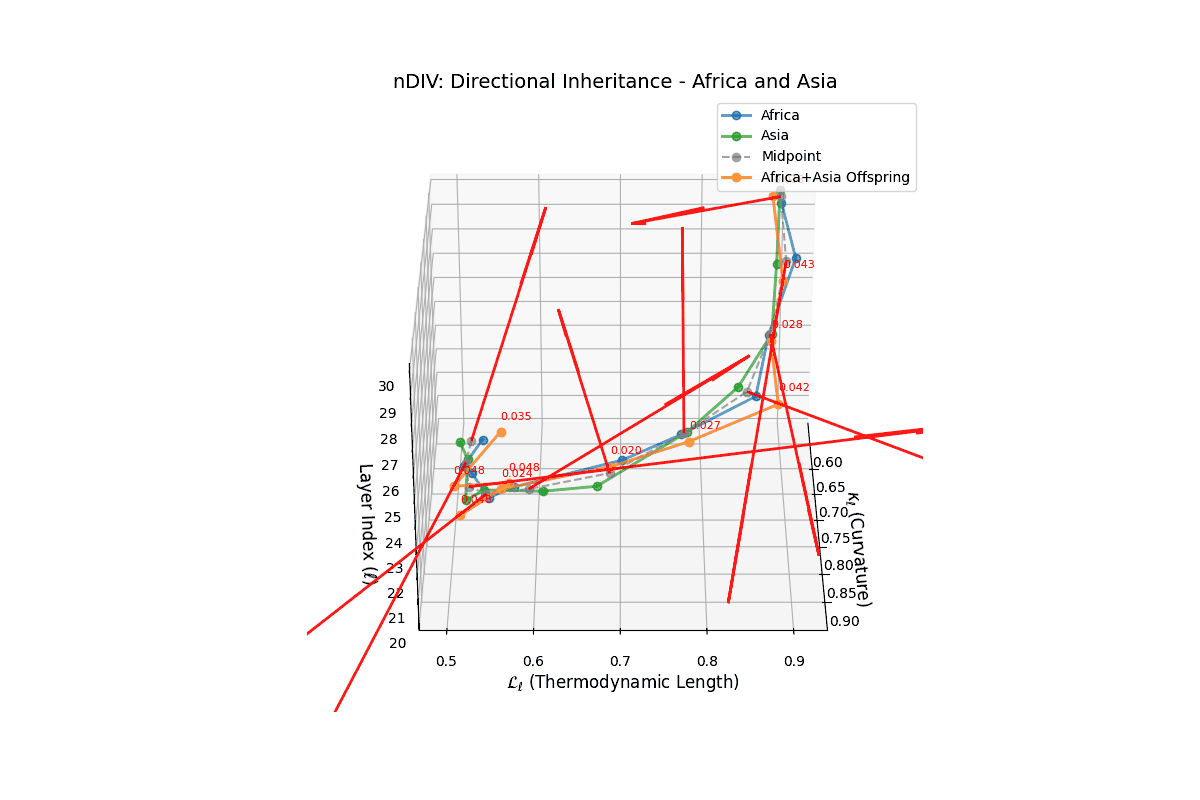
This plot illustrates layer-wise directional inheritance ($\ell \in[20, 30]$) in the semantic latent space, represented by spectral curvature κℓ and thermodynamic length $L_\ell$. The offspring model (orange) demonstrates a nuanced directional bias shifting between Africa (blue) and Asia (green), reflecting complex, nonlinear semantic recombination. Notably, mid-layers exhibit near-zero directional values, suggesting emergent semantic traits distinct from parental influences, a hallmark of epigenetic-like adaptation in model fusion.
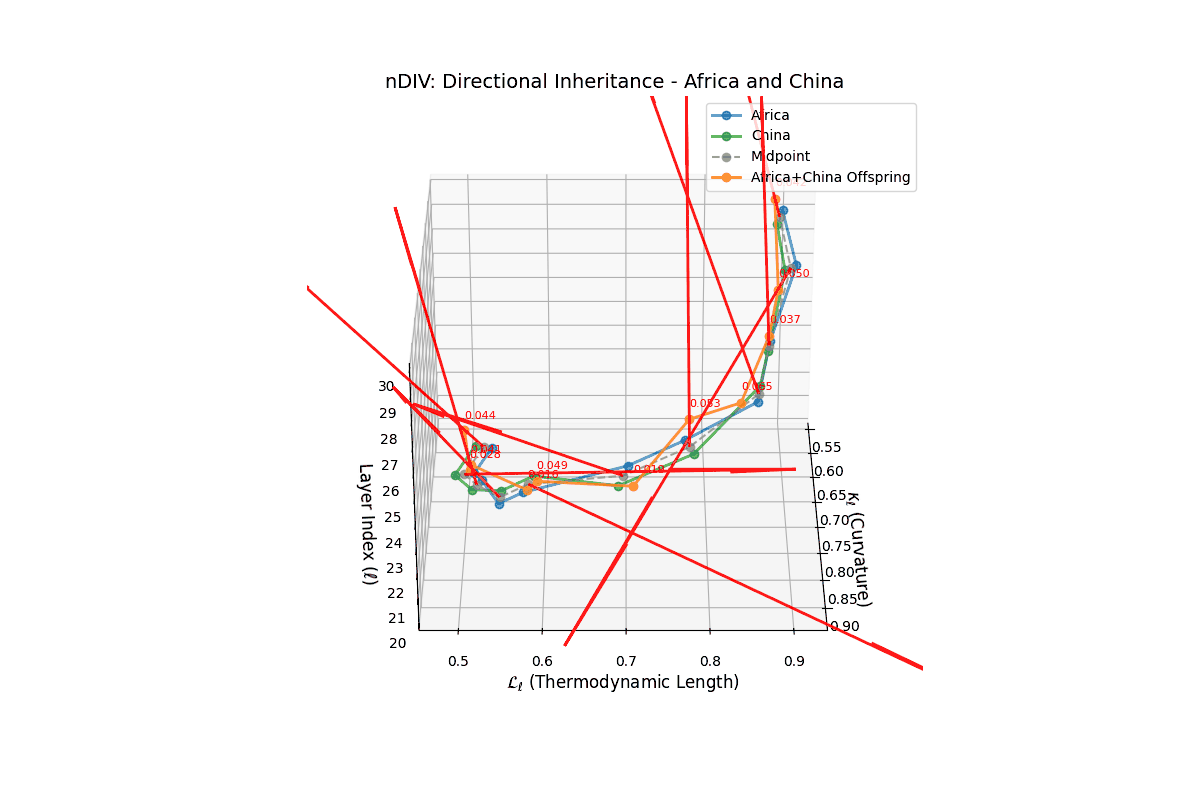
The offspring semantic trajectory (orange) reveals a stronger affinity toward Africa in early transformer layers ($\ell \approx 20 - 23 $), as indicated by positive directional cosine values. Deeper layers show more balanced influence, with semantic traits converging between parents. This layered pattern highlights the selective inheritance of lexical richness and conceptual features, mirroring biological directional selection where phenotypic traits shift non-uniformly under environmental pressure
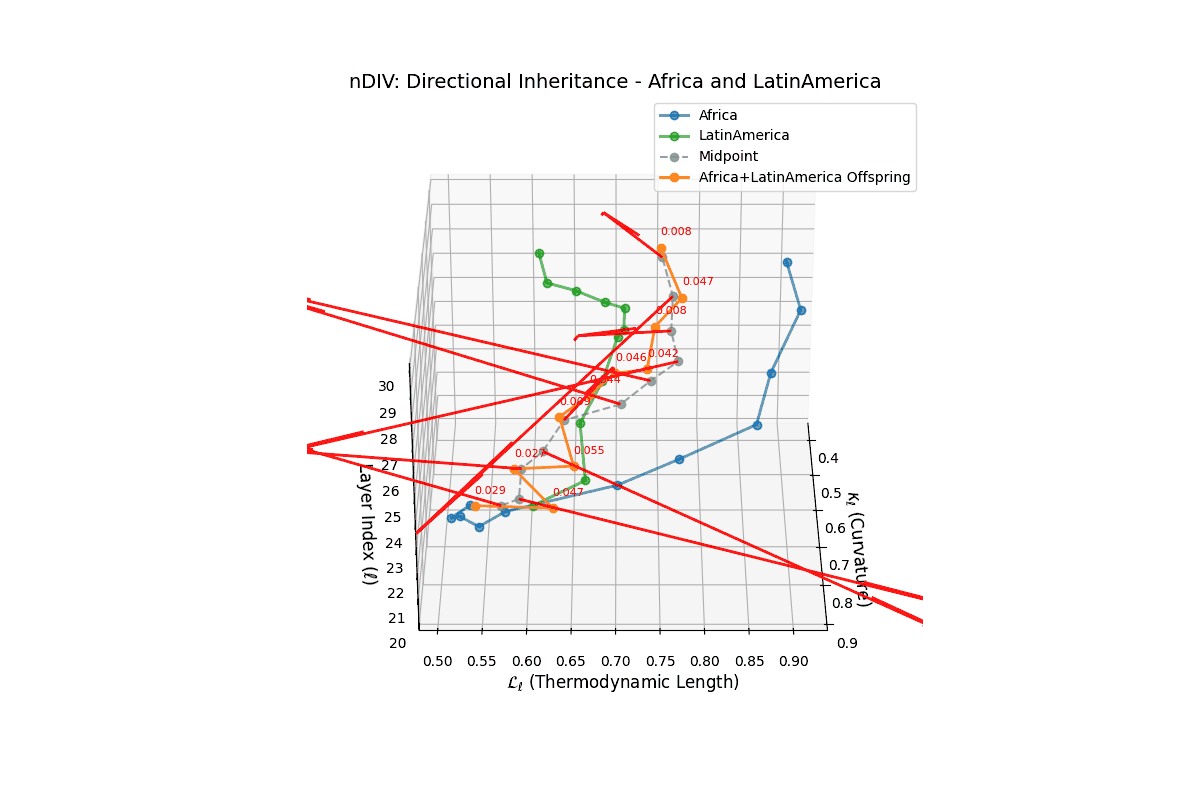
The offspring (orange) exhibits a pronounced directional bias toward Africa in early and mid layers ($\ell \in [20, 27]$), with a subsequent shift toward Latin America in deeper layers. This suggests a layerwise semantic specialization where foundational lexical and syntactic features originate from Africa, while higher-level thematic or stylistic traits derive from Latin America. The directionality metric effectively quantifies this complex inheritance interplay, essential for nuanced model merging and alignment control.
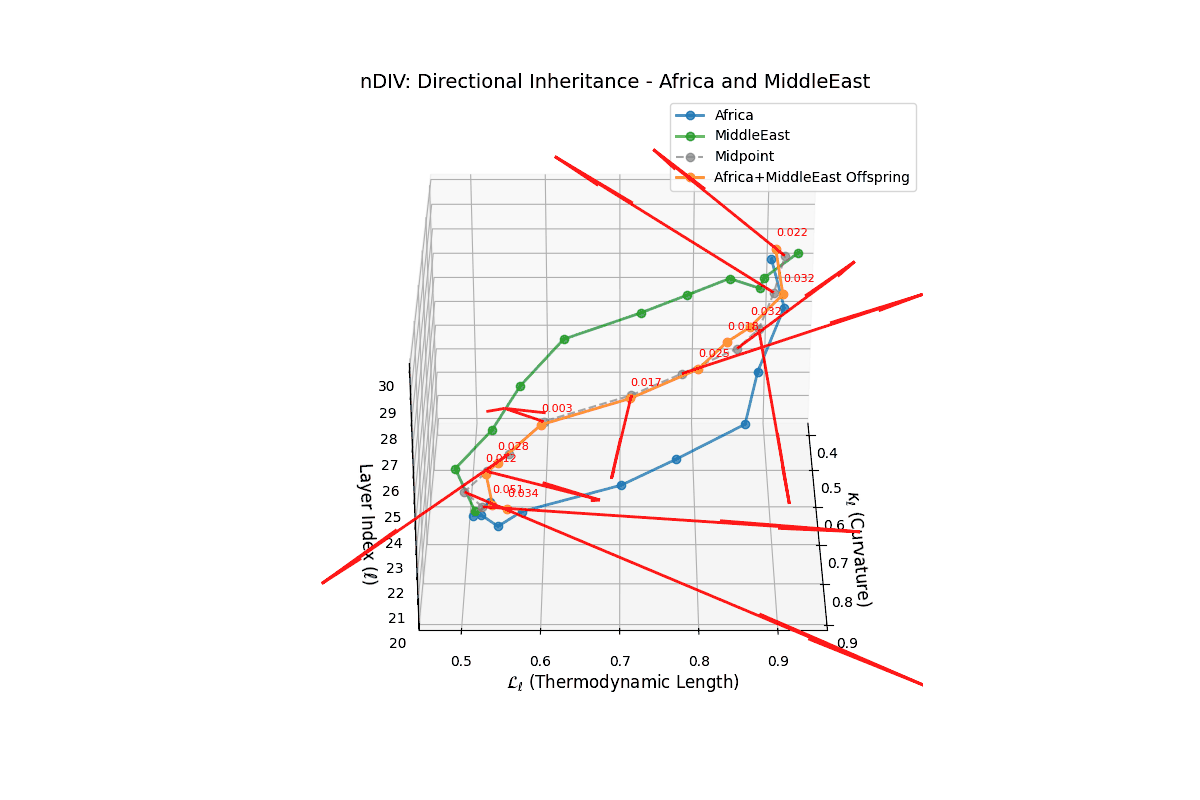
Here, the offspring model’s inheritance trajectory reveals a dominant directional pull toward Africa in early layers, gradually transitioning to a balanced mixture in mid and deep layers ($\ell \in [20, 30]$). This pattern indicates dynamic semantic recombination akin to biological mosaicism, where diverse traits are selectively expressed across functional layers. Such insights enable layer-specific interpretability and targeted interventions during semantic fusion and fine-tuning processes.
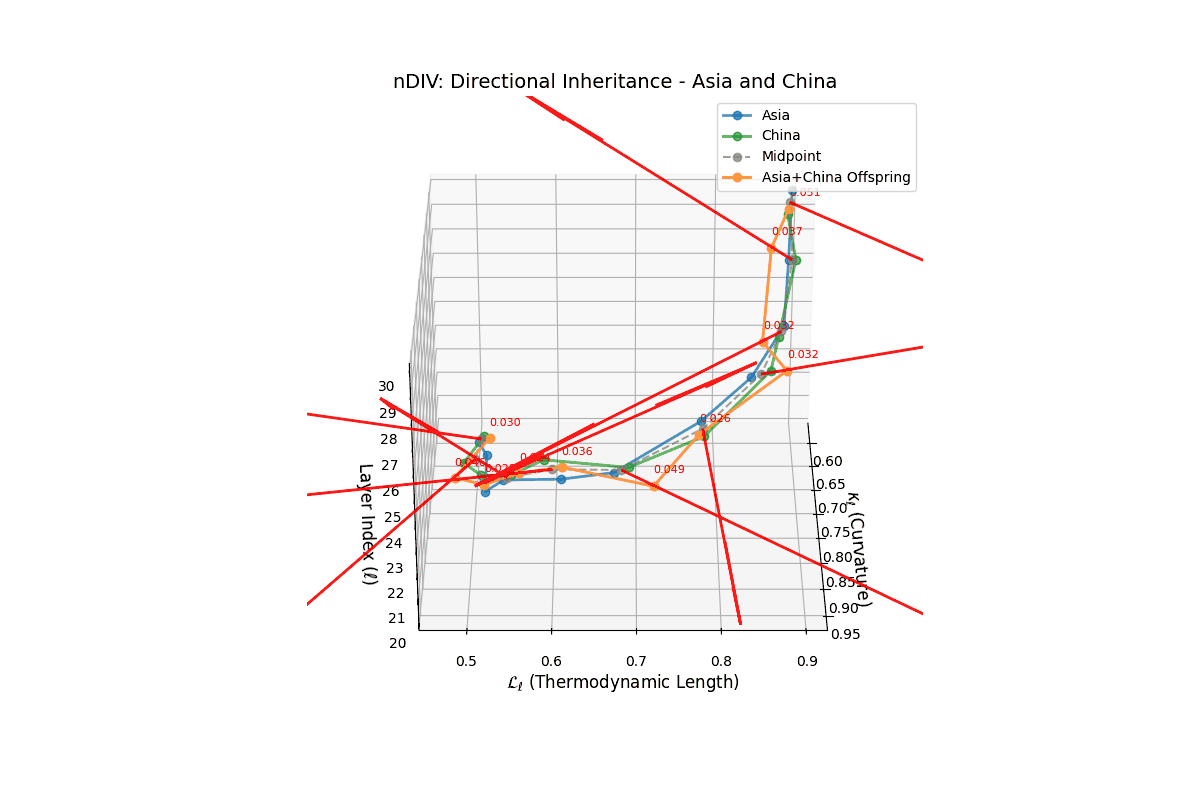
This visualization captures the directional semantic inheritance in the latent space between Asia and China parent models and their offspring across transformer layers $\ell \in [20, 30]$. Here, the $\kappa_\ell$ (spectral curvature) and $L_\ell$ (thermodynamic length) trajectories reveal a pronounced affinity of the offspring toward China’s latent semantic features in earlier layers, gradually integrating Asia’s deeper-layer conceptual traits. The $\vec{\mathrm{nDIV}}_\ell$ metric quantifies this inheritance directionality, highlighting layer-specific semantic dominance shifts and emergent latent trait recombinations reflective of evolutionary-like selective pressures in neural representations.
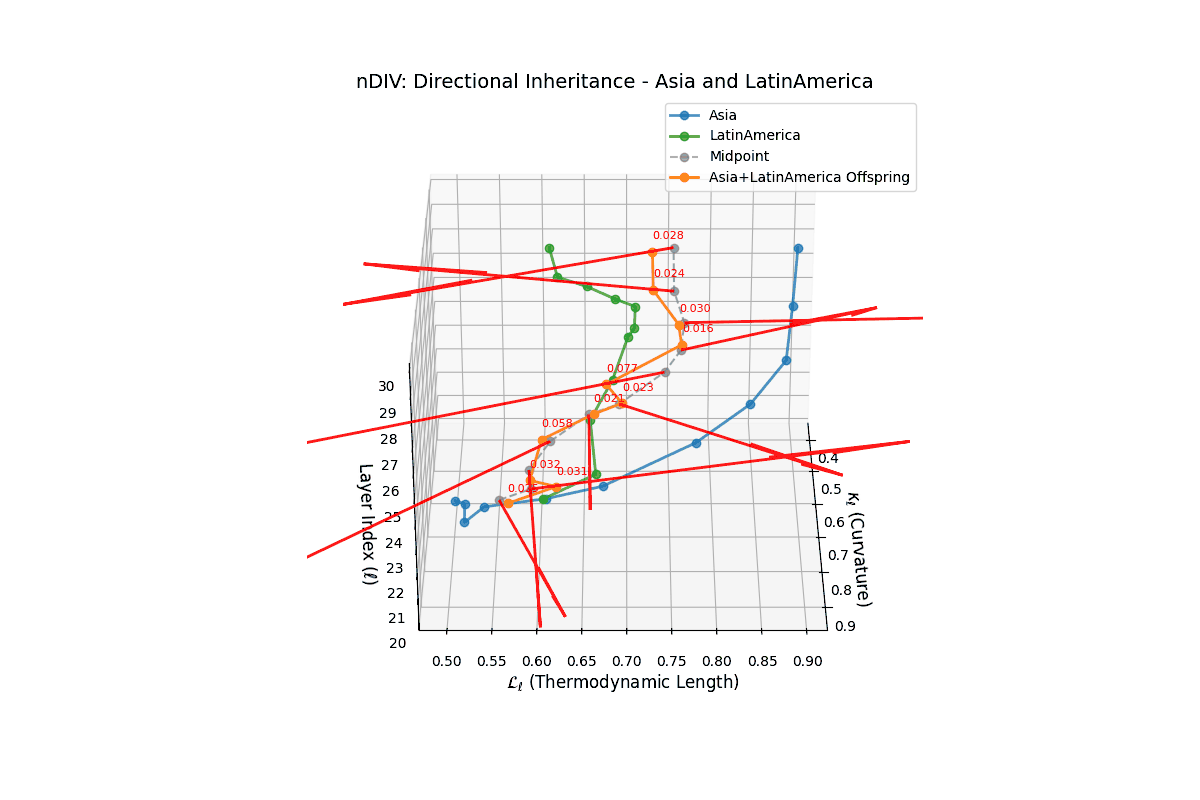
The offspring model exhibits a complex semantic recombination across layers $\ell \in [20, 30]$, with initial dominance of Asia’s $\kappa_\ell$ and $L_\ell$ patterns transitioning to Latin America’s deeper-layer influences. The $\vec{\mathrm{nDIV}}_\ell$ vectors quantify the dynamic inheritance direction, revealing non-linear, emergent semantic configurations indicative of latent epigenetic modulation-like effects, where neural traits adaptively shift reflecting cultural and conceptual blending beyond simple averaging. This analysis underscores the multi-dimensional and hierarchical nature of semantic lineage in LLM fusion.
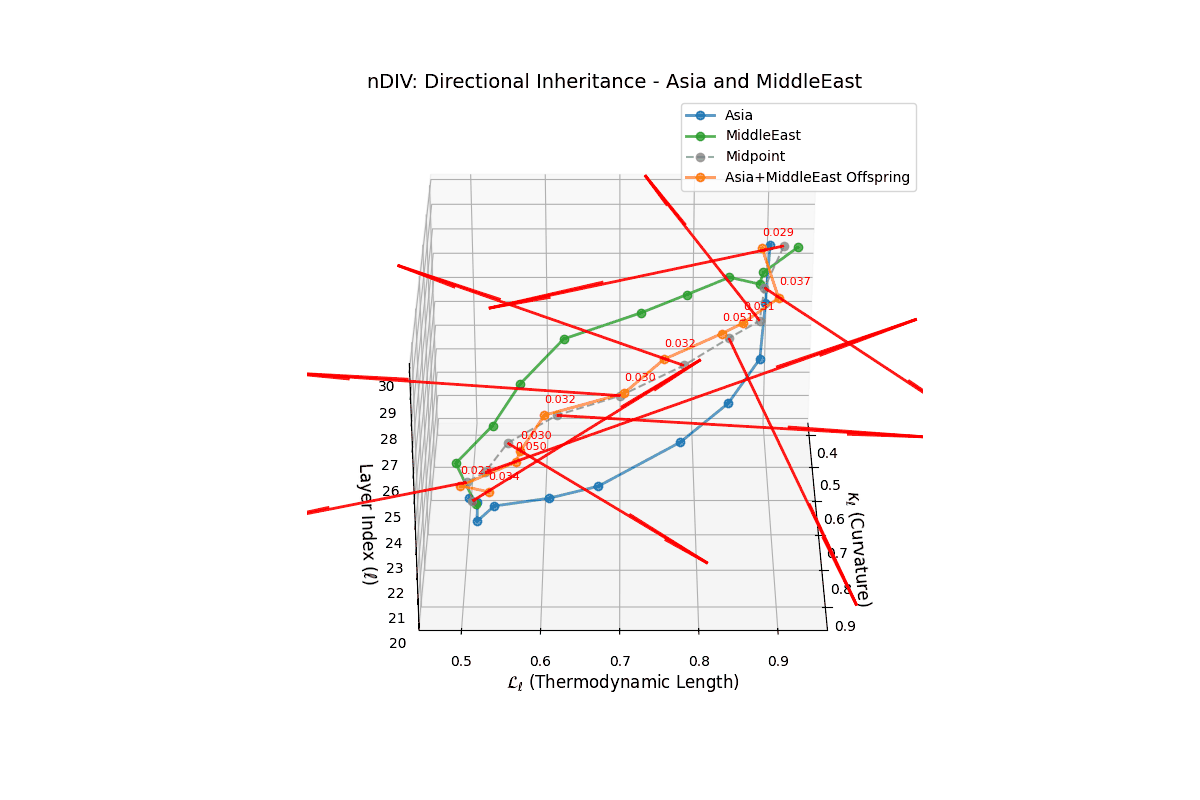
The directional inheritance landscape across $\ell \in [20, 30]$ layers illustrates a nuanced interplay between Asia’s and Middle East’s latent semantic manifolds. Offspring models show selective inheritance with clear biases toward Asia in early layers and Middle East in later layers, captured by the divergence in $\kappa_\ell$ and $L_\ell$ as well as the $\vec{\mathrm{nDIV}}_\ell$ directionality. This suggests layer-wise functional specialization and semantic niche adaptation, akin to biological adaptive radiation, where latent trait inheritance follows evolutionary pressures shaped by diverse cultural priors.
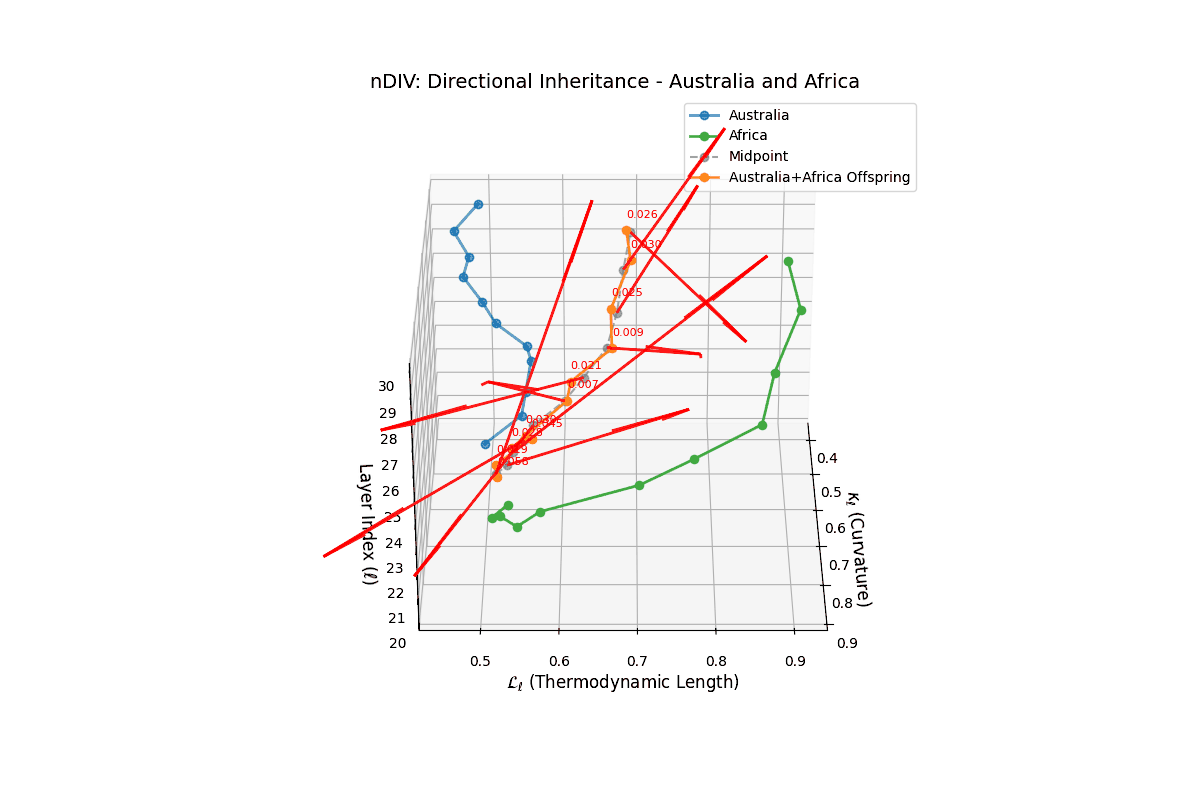
The offspring latent semantic trajectory demonstrates a sophisticated fusion of Australia and Africa parental traits across layers $\ell \in [20, 30]$. The $\vec{\mathrm{nDIV}}\ell$ reveals a predominant directional inheritance toward Africa’s deeper-layer traits ($\kappa\ell$, $L_\ell$) with intermittent integration of Australia’s early-layer features. This layered inheritance pattern illustrates hierarchical semantic recombination and epigenetic-like latent plasticity, emphasizing the rich semantic dynamics involved in cross-cultural neural model merging.
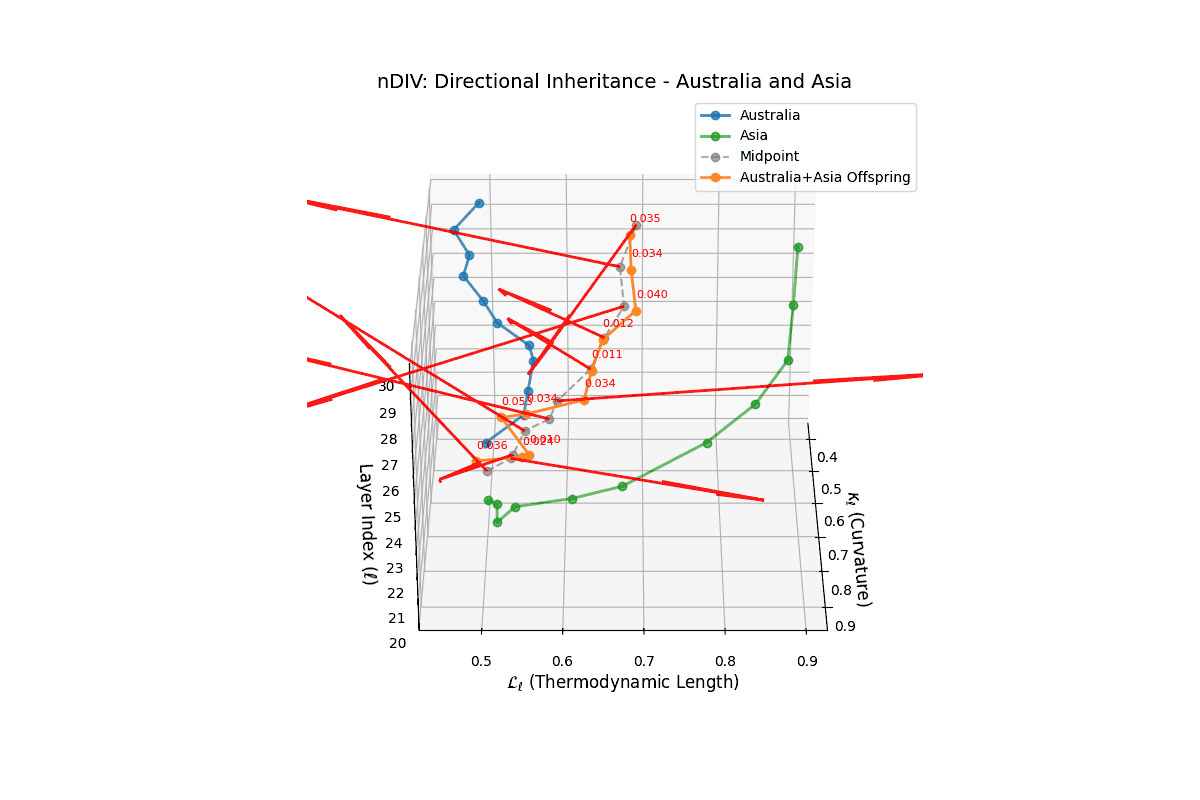
This visualization depicts the layer-wise directional inheritance for transformer layers $\ell \in [20, 30]$ in terms of spectral curvature $\kappa_\ell$ and thermodynamic length $L_\ell$. The offspring (orange) reflects a hybrid semantic trajectory predominantly influenced by Australia (blue) in early layers and gradually aligning with Asia (green) in deeper layers. The directionality values highlight complex semantic recombination, suggesting nonlinear blending and emergent features beyond parameter averaging.
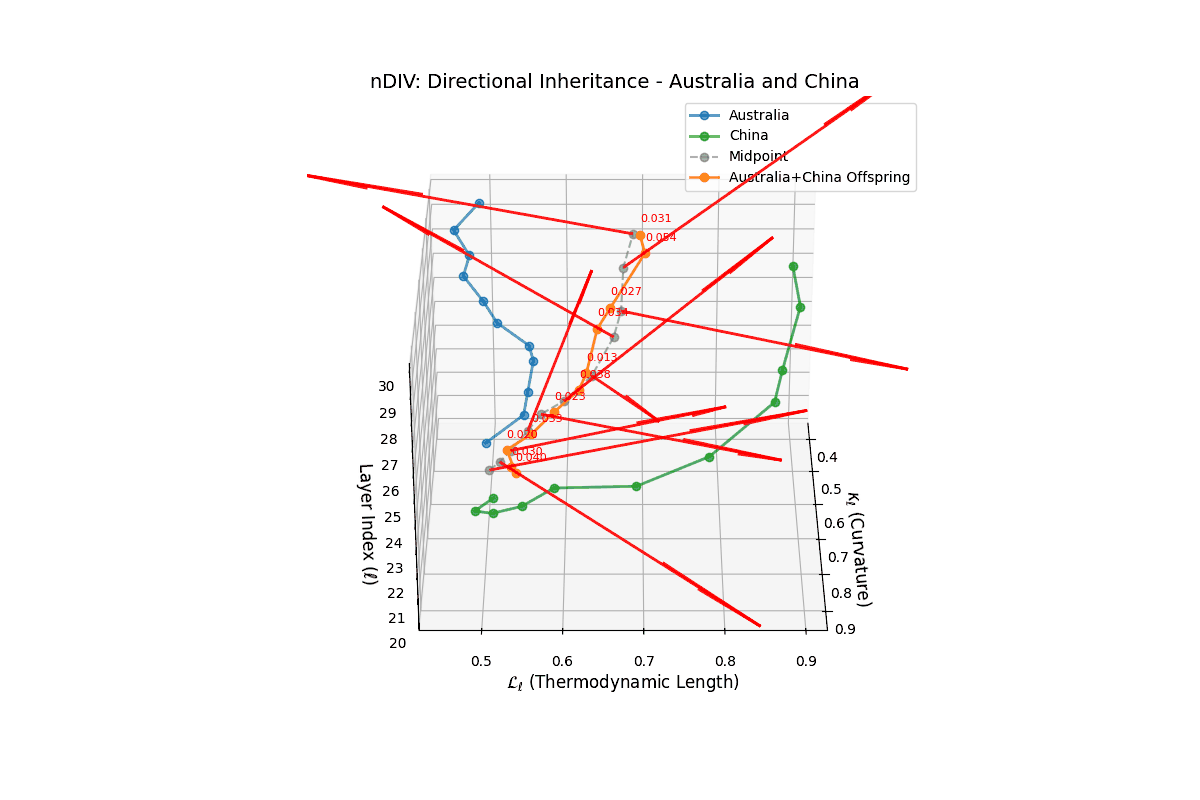
Here, the offspring semantic profile (orange) shows stronger directional affinity toward Australia in the initial layers ($\ell \in [20, 24]$), gradually shifting to a more balanced influence with China (green) in deeper layers. The midpoint layer behavior reflects nuanced semantic fusion, reminiscent of phenotypic plasticity in biological systems where environmental pressures modulate gene expression. These directional tendencies emphasize layer-specific semantic specialization that informs model merging strategies for balanced knowledge integration.
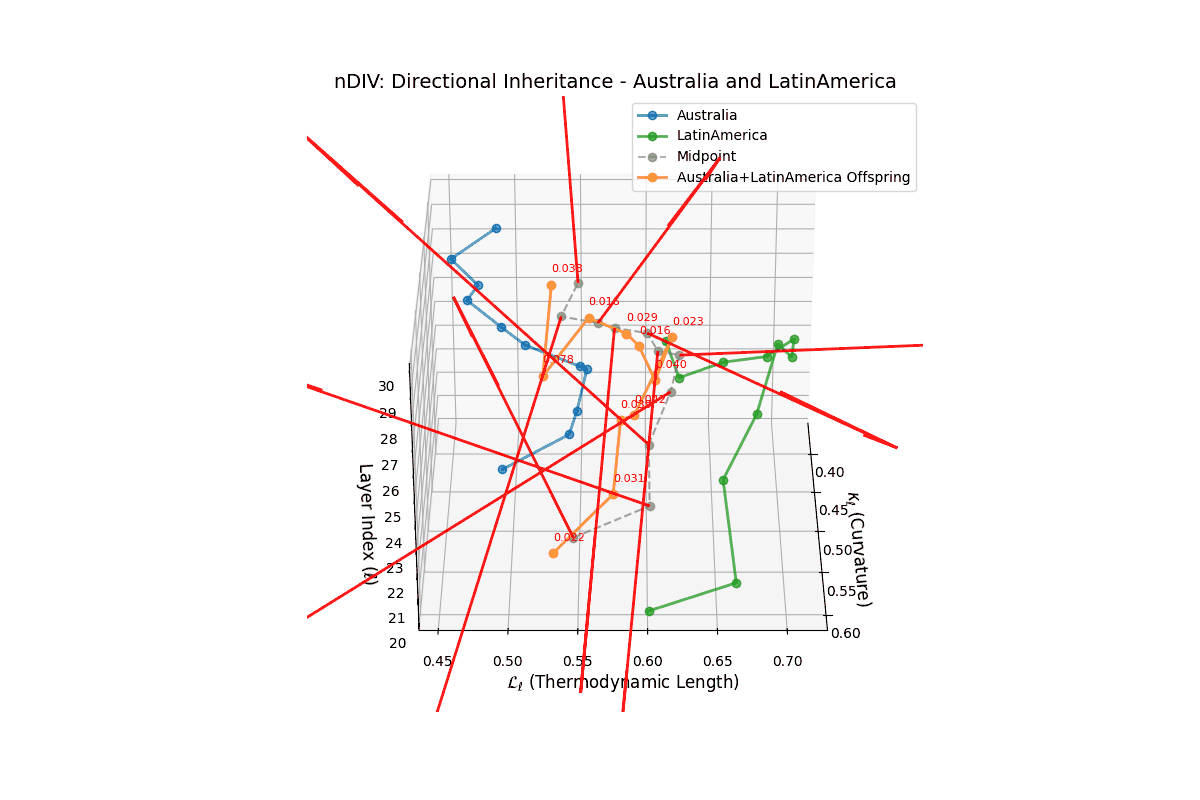
The offspring model (orange) demonstrates a pronounced directional bias toward Australia in early to mid layers $\ell \in [20, 27]$, with a gradual transition toward Latin America (green) in the deeper layers. This layered directional pattern indicates semantic modularity, where foundational linguistic and syntactic traits are predominantly inherited from Australia, while cultural and thematic nuances emerge from Latin America. This analysis reveals complex inheritance interplay, crucial for fine-tuning and interpretability in multilingual fusion.
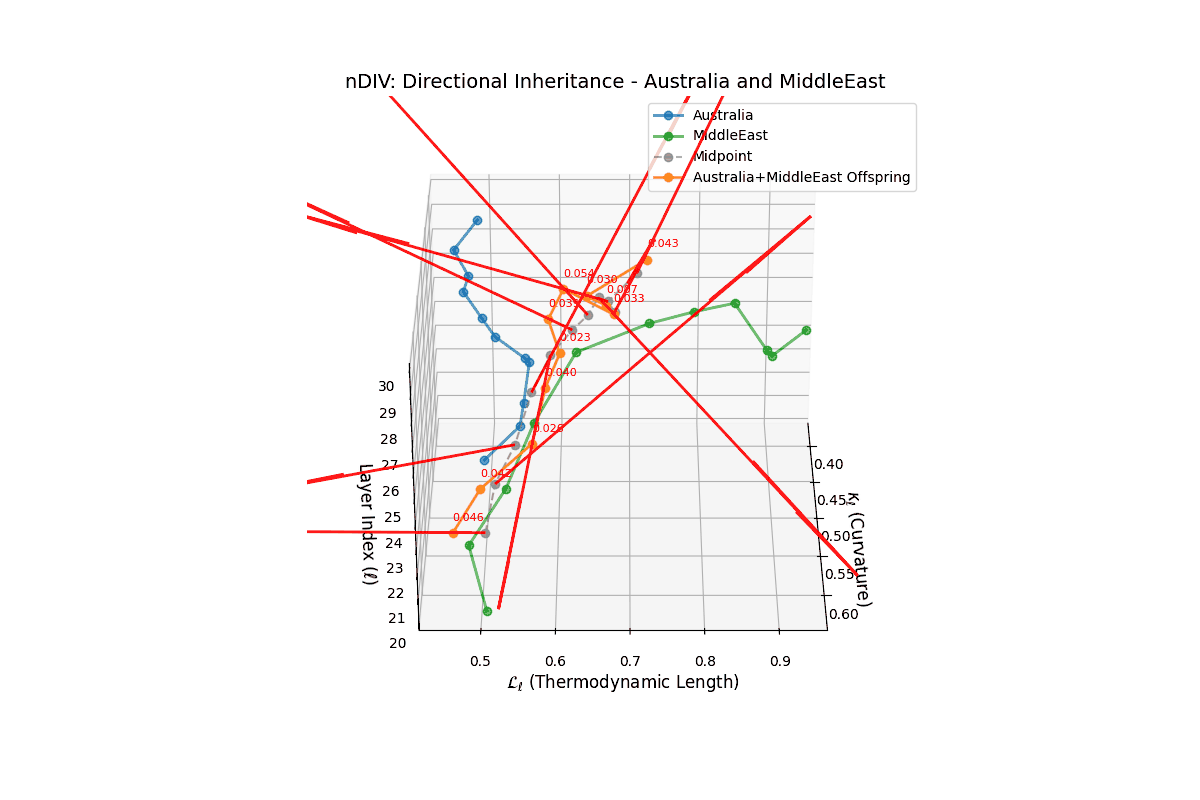
This figure illustrates the offspring model’s directional inheritance trajectory, showing dominant pull toward Australia in early layers, transitioning to a more balanced semantic mixture with the Middle East (green) in mid to deep layers $\ell \in [20, 30]$. The directional vector magnitudes reveal intricate recombination resembling mosaic inheritance, where heterogeneous traits co-exist and dynamically influence model behavior.
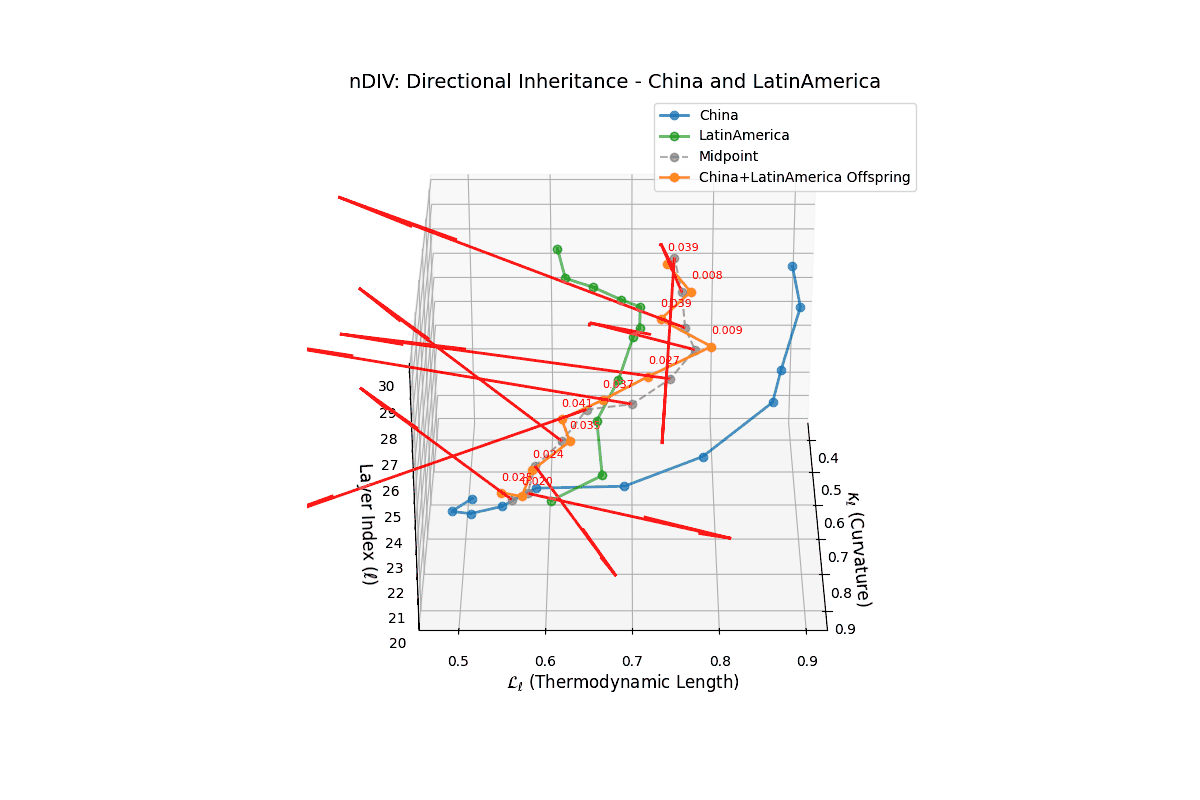
This plot captures layerwise directional inheritance ($\ell \in [20, 30]$) in semantic latent space, represented by spectral curvature $\kappa_\ell$ and thermodynamic length $L_\ell$. The offspring model (orange) shows a pronounced early affinity toward China ($\kappa_\ell, L_\ell \approx 0.8, 0.9$) in initial layers ($\ell \approx 20$–$24$), shifting toward a Latin America semantic influence in deeper layers ($\ell \approx 25$–$30$) where $\kappa_\ell, L_\ell \approx 0.4, 0.5$. The midpoint (gray) trajectory indicates balanced blending. This layered pattern reflects semantic specialization with foundational lexical traits from China and higher-level thematic features from Latin America.
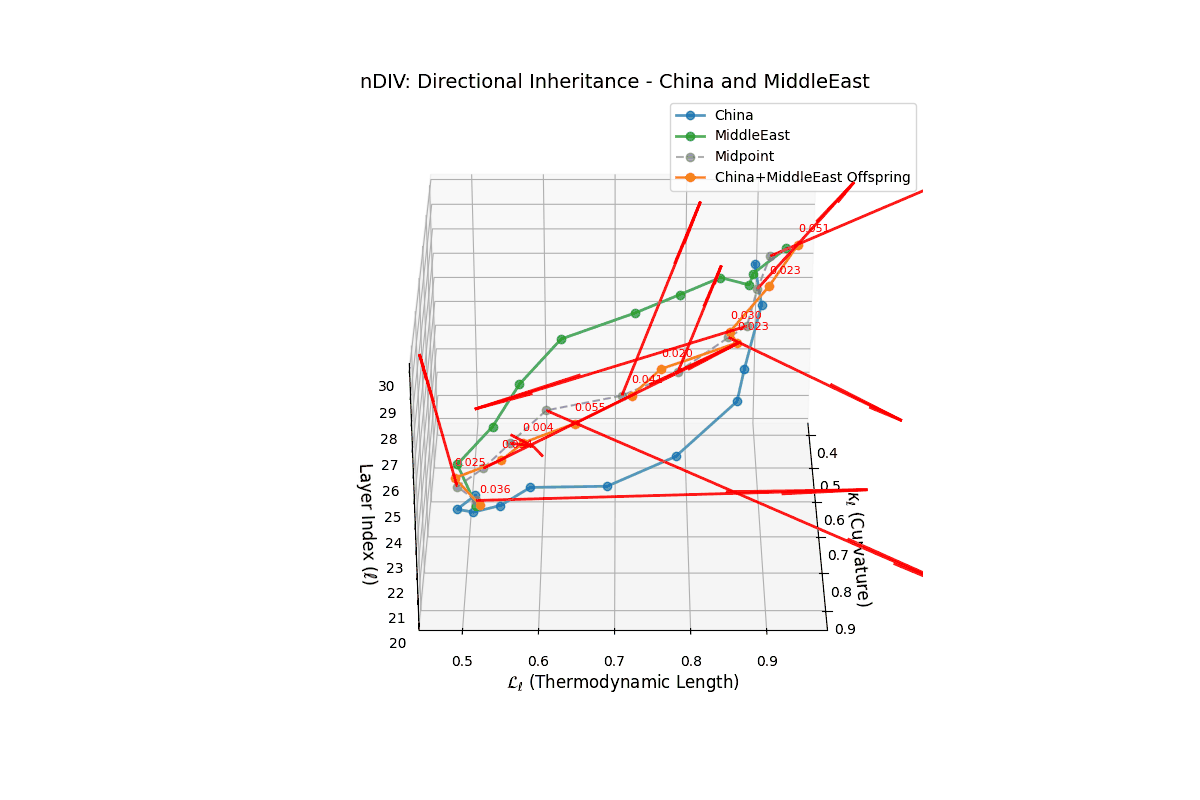
The offspring’s directional inheritance (orange) across transformer layers $\ell \in [20, 30]$, characterized by $\kappa_\ell$ and $L_\ell$, shows a strong early layer pull toward China ($\kappa_\ell \approx 0.9, L_\ell \approx 0.85$ at $\ell = 20$) transitioning to a balanced blend with Middle East semantics at deeper layers ($\kappa_\ell, L_\ell \approx 0.5, 0.6$ for $\ell = 25$–$30$). This mosaic-like pattern suggests selective semantic recombination where distinct layerwise traits from both parents contribute differentially to the offspring’s overall latent geometry, enabling nuanced interpretability and tuning opportunities.
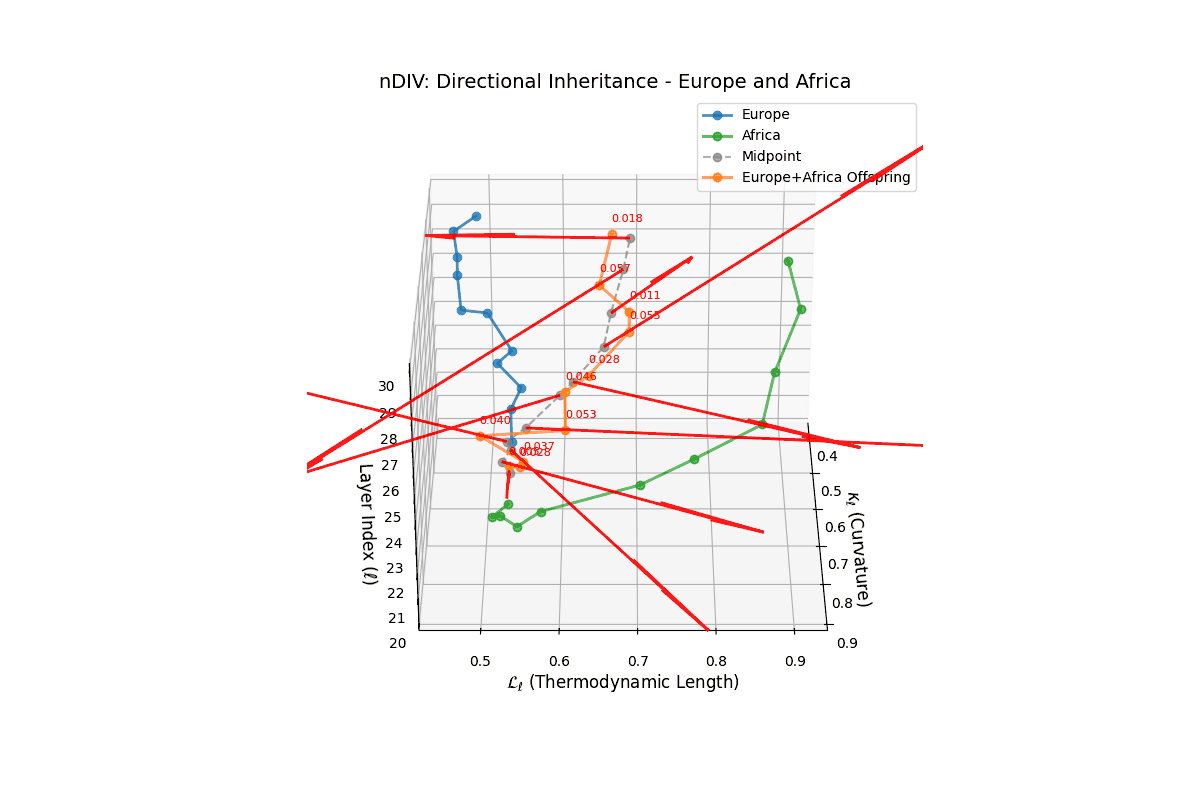
This offspring model’s semantic inheritance is mapped over layers $\ell \in [20, 30]$ using spectral curvature $\kappa_\ell$, thermodynamic length $L_\ell$. Initial layers exhibit strong European influence ($\kappa_\ell \approx 0.85, L_\ell \approx 0.9$), while midlayers show dominant African semantic traits ($\kappa_\ell \approx 0.5, L_\ell \approx 0.6$). The deeper layers present a complex admixture with emergent semantic features beyond parental contributions. This layerwise pattern reflects epigenetic-like dynamics of fusion essential for cross-cultural model merging and fine-tuning interpretability.
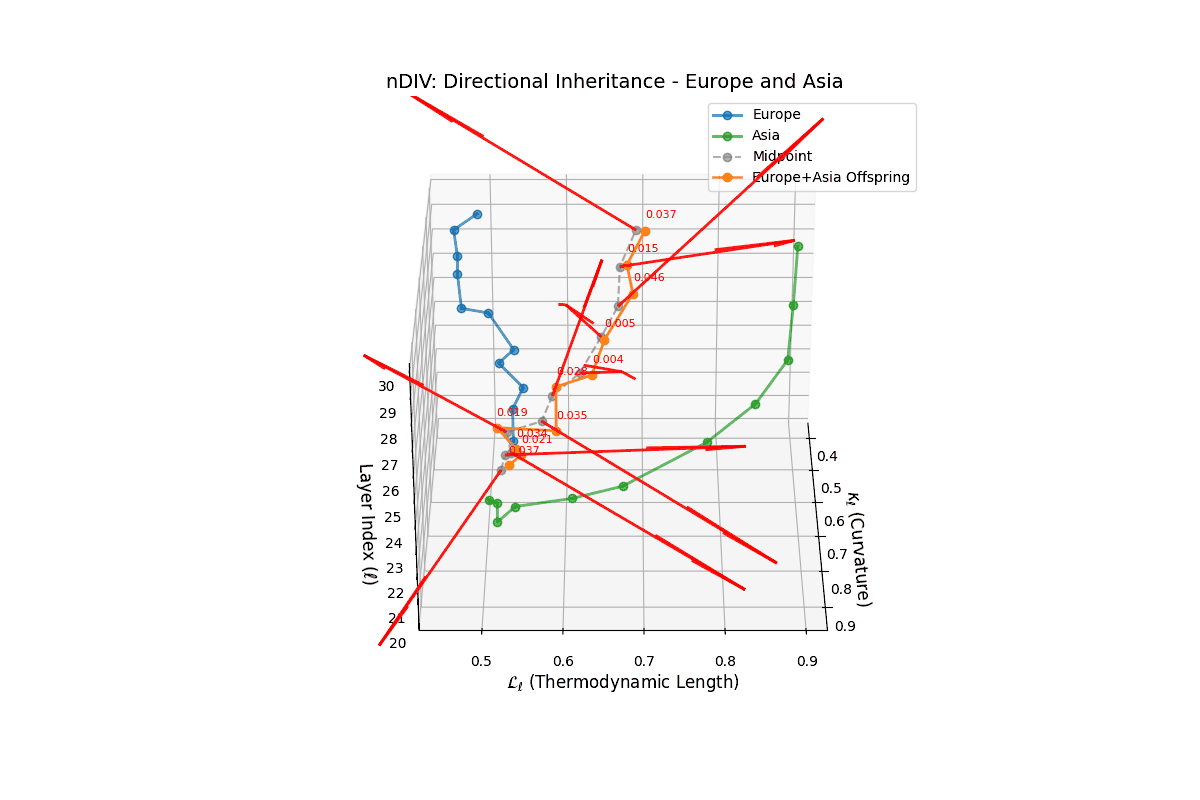
The offspring model’s inheritance trajectory over layers $\ell \in [20, 30]$ shows a pronounced early and mid-layer directional bias toward Europe ($\kappa_\ell \approx 0.9, L_\ell \approx 0.85$), while deeper layers exhibit a convergent blend of European and Asian semantic traits ($\kappa_\ell, L_\ell \approx 0.6, 0.55$). This nonlinear interaction reveals emergent semantic traits critical for layer-specific interpretability, fusion control, and alignment preservation in multicultural model merges.
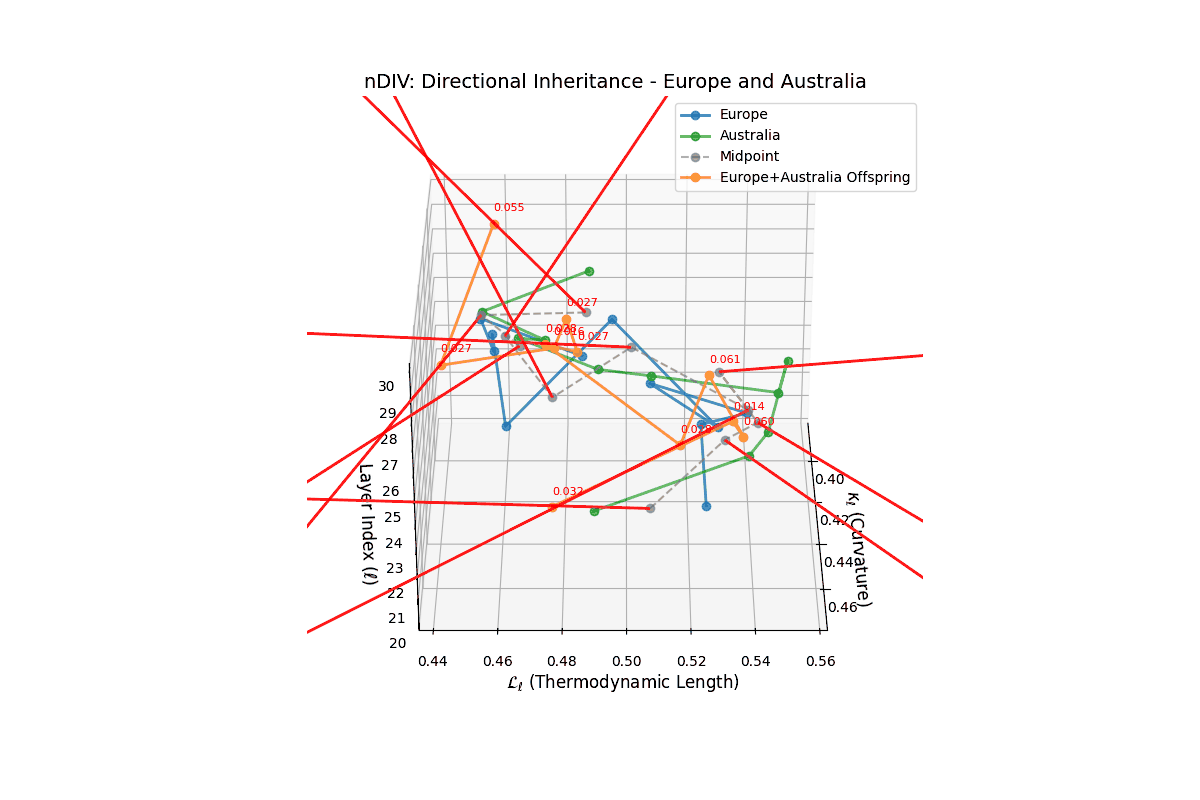
This plot depicts the layer-wise directional inheritance ($\ell \in [20, 30]$) across spectral curvature $\kappa_\ell \in [0.39, 0.47]$ and thermodynamic length $L_\ell \in [0.44, 0.56]$. The offspring model (orange) exhibits dynamic shifts between Europe (blue) and Australia (green), with early layers favoring Europe’s semantic traits, transitioning towards Australia’s influence in mid to deep layers. This layered pattern suggests functional specialization during semantic fusion, reflecting a balance of lexical and conceptual inheritance. The value annotations highlight subtle yet significant directional deviations instrumental in controlled model alignment.
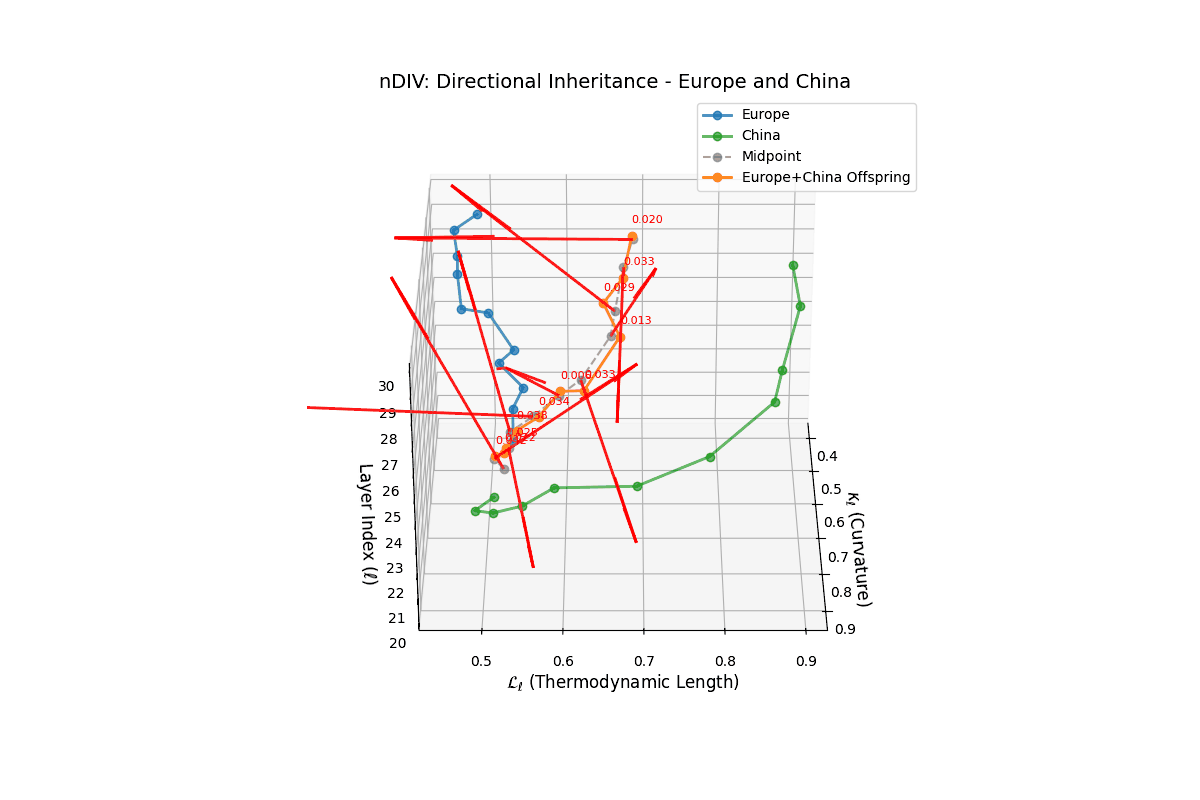
The offspring semantic trajectory (orange) navigates the $\kappa_\ell \in [0.39, 0.47]$ and $L_\ell \in [0.43, 0.55]$ ranges over layers $\ell \in [20, 30]$, demonstrating layer-dependent affinity predominantly towards Europe (blue) in early layers, shifting towards China (green) at mid-depths. This reflects selective semantic blending, where foundational conceptual embeddings are inherited from Europe, while lexical diversity emerges from China in deeper layers. Such directionality captures nonlinear semantic recombination, critical for nuanced understanding of model offspring behavior and semantic alignment strategies.
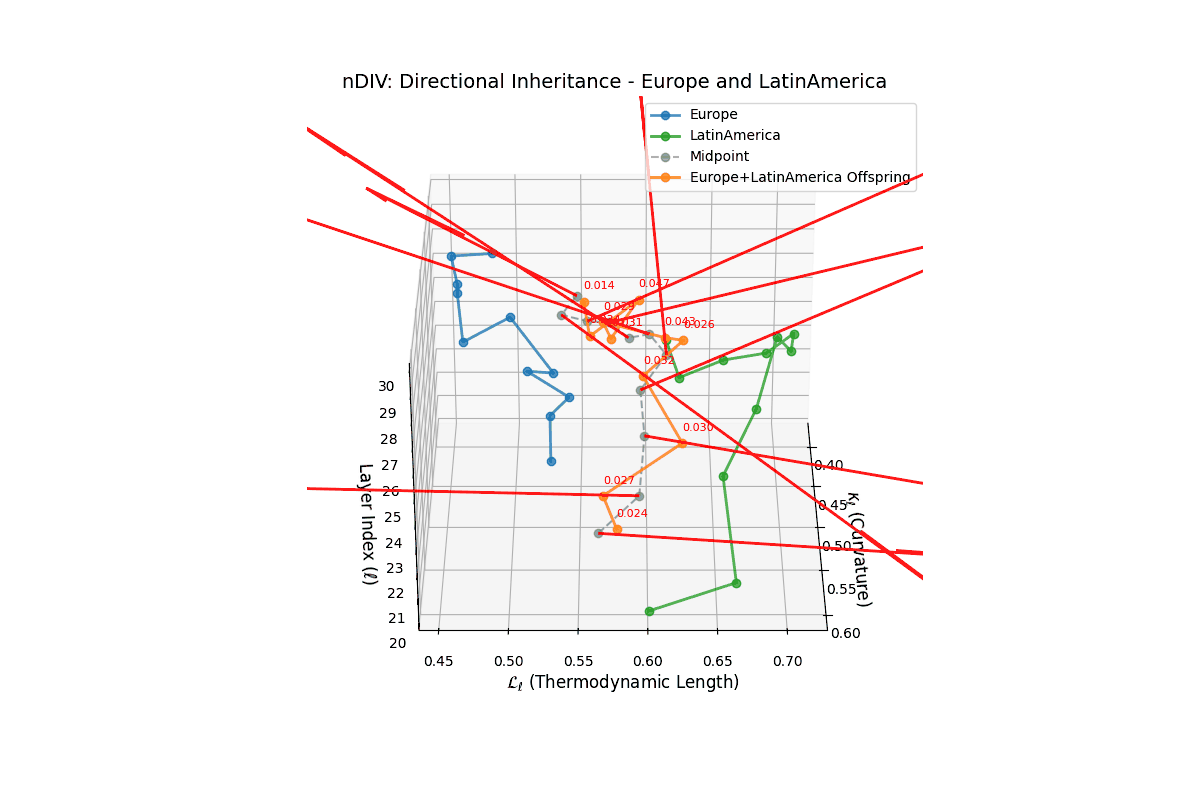
Across layers $\ell \in [20, 30]$, the offspring model (orange) traverses the latent semantic space defined by $\kappa_\ell \in [0.40, 0.60]$ and $L_\ell \in [0.45, 0.70]$, revealing a progressive semantic shift from Europe (blue) dominance in early layers towards Latin America (green) influence in later layers. This indicates graduated transfer of thematic and stylistic features, mirroring hierarchical semantic inheritance akin to biological epigenetics. The directionality metric thus quantifies intricate semantic trait integration essential for effective model fusion and alignment.
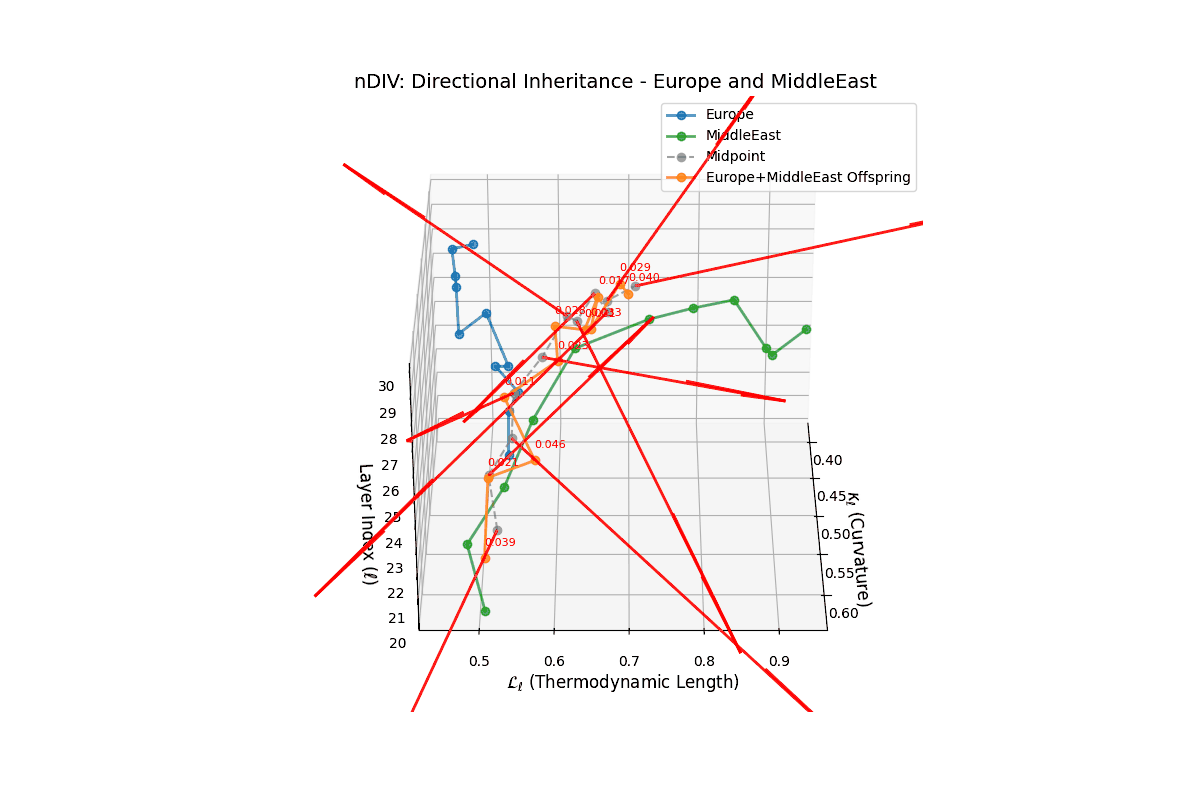
This visualization tracks offspring inheritance over layers $\ell \in [20, 30]$ within the spectral curvature range $\kappa_\ell \in [0.40, 0.65]$ and thermodynamic length $L_\ell \in [0.45, 0.70]$. The offspring model (orange) demonstrates a complex directional blend with early layers showing affinity to Europe (blue) and deeper layers mixing traits from both Europe and Middle East (green). Such layer-specific semantic mosaicism highlights the intricate interplay of cultural and linguistic features during model merging, providing a basis for interpretable and controlled semantic alignment.
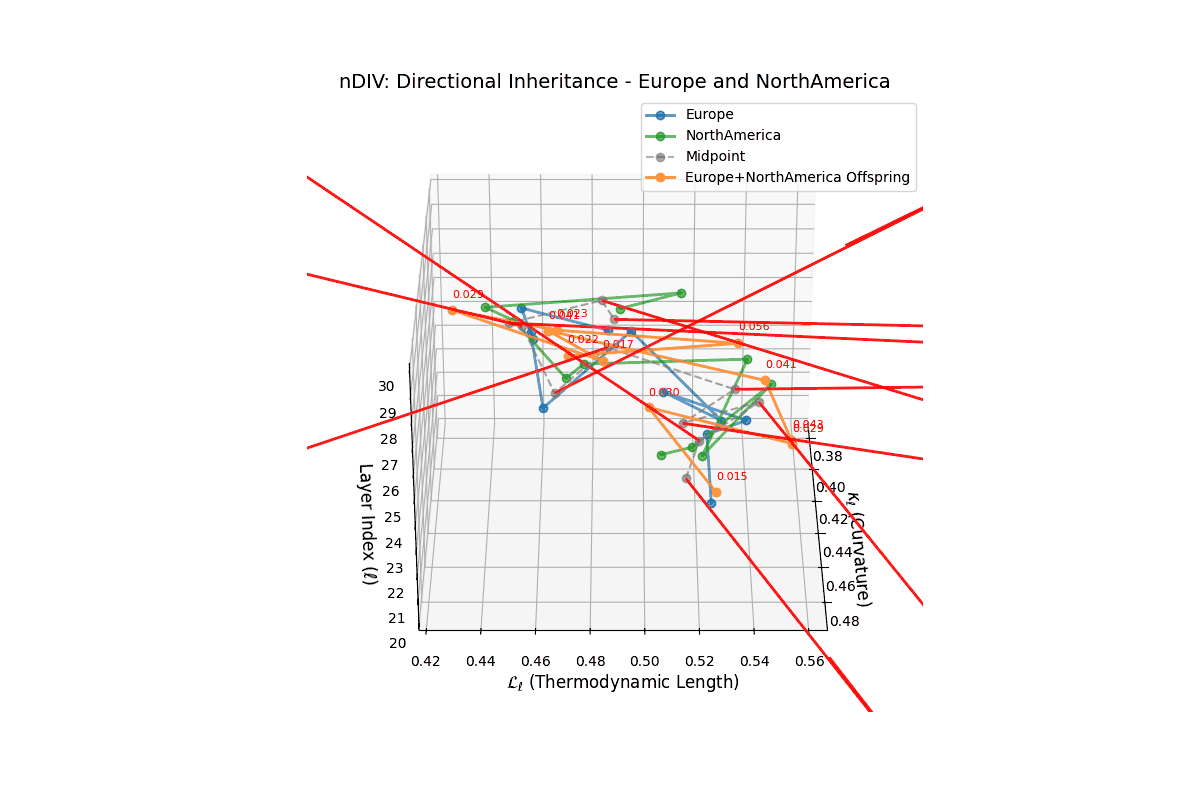
Layers $\ell \in [20, 30]$ show offspring (orange) semantic shifts over curvature $\kappa_\ell \in [0.38, 0.48]$ and thermodynamic length $L_\ell \in [0.42, 0.56]$. Early layers reflect Europe’s semantic core (blue), transitioning toward North America’s traits (green) in deeper layers. This reflects hierarchical blending where foundational embeddings precede thematic diversity, highlighting controlled fusion of lexical and conceptual features during model merging. Directional deviations mark subtle semantic realignments essential for downstream tasks and interpretability.
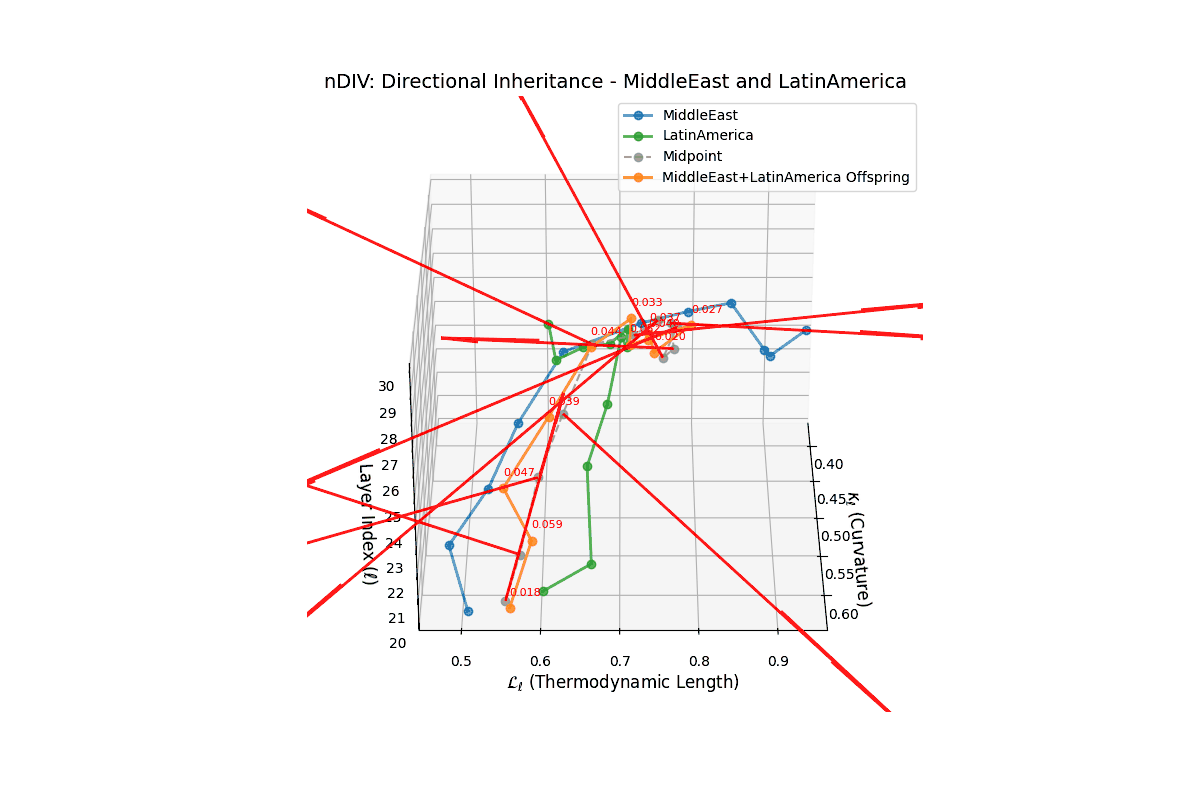
The offspring model (orange) spans layers $\ell \in [20, 30]$, covering curvature $\kappa_\ell \in [0.40, 0.65]$ and length $L_\ell \in [0.45, 0.70]$. Early layers align with Middle East’s semantic patterns (blue), while deeper layers shift towards Latin America (green), capturing complex semantic blending. This layered mosaicism shows integration of distinct cultural features, balancing syntactic structure and stylistic richness, crucial for interpretability and alignment in semantic fusion.
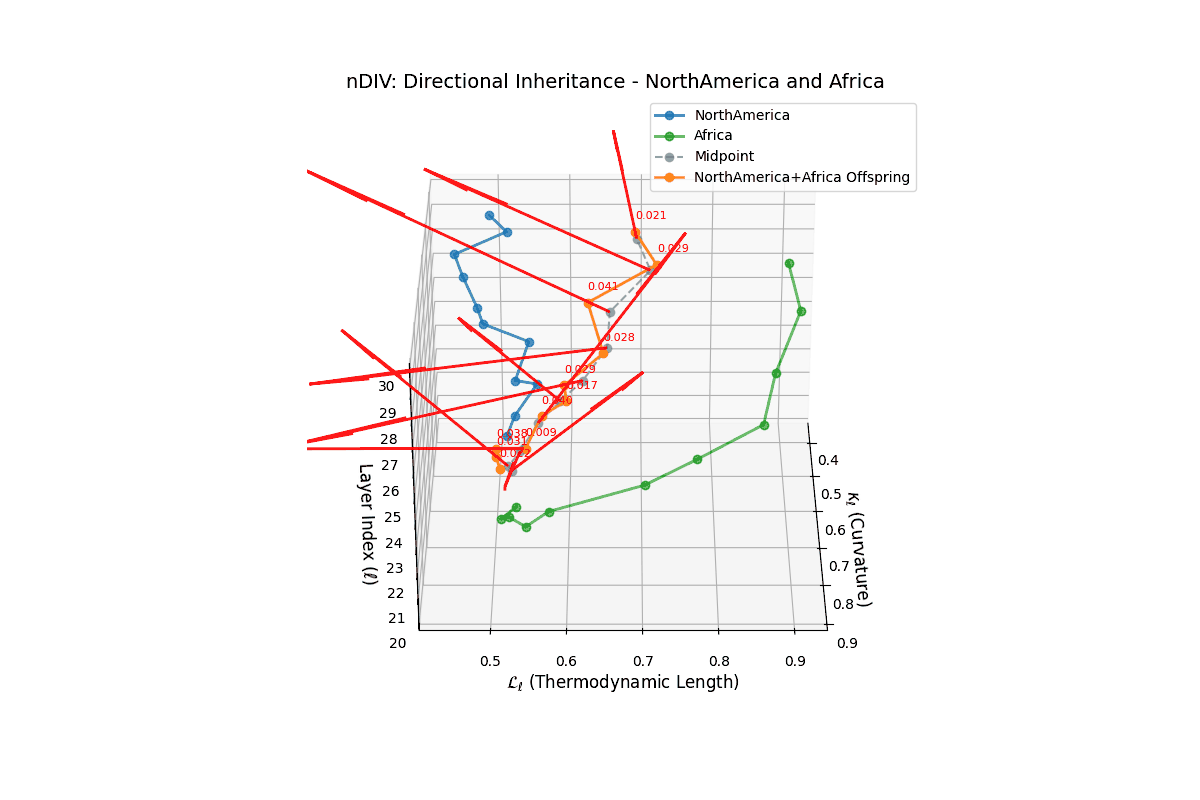
Over layers $\ell \in [20, 30]$, the offspring’s semantic trajectory (orange) spans curvature $\kappa_\ell \in [0.38, 0.90]$ and thermodynamic length $L_\ell \in [0.42, 0.55]$, illustrating directional shifts between North America (blue) and Africa (green). Early layers emphasize Africa’s lexical diversity, while deeper layers reflect North America’s thematic focus. This nonlinear recombination highlights the nuanced interplay of cultural and conceptual features, revealing layer-specific realignments essential for enhanced interpretability and controlled semantic fusion. Value annotations mark key deviations significant for understanding alignment dynamics.
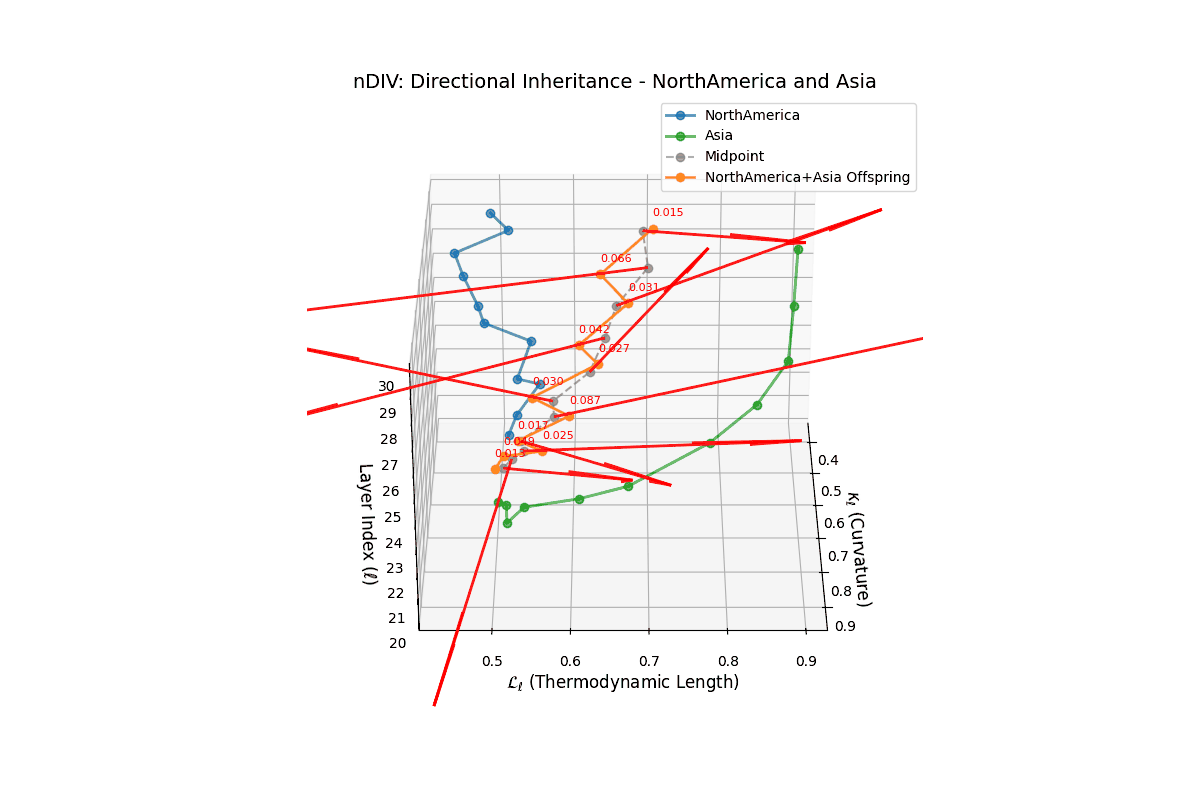
The offspring semantic path (orange) across layers $\ell \in [20, 30]$ explores curvature $\kappa_\ell \in [0.40, 0.60]$ and thermodynamic length $L_\ell \in [0.42, 0.60]$, showing an initial dominance of North America’s semantic traits (blue) gradually blending with Asia’s features (green) in deeper layers. This progression reflects a layered semantic fusion process where conceptual stability provided by North America precedes cultural enrichment from Asia. The nuanced directional shifts elucidate the mechanics of controlled alignment and contribute to improved interpretability in model offspring fusion.
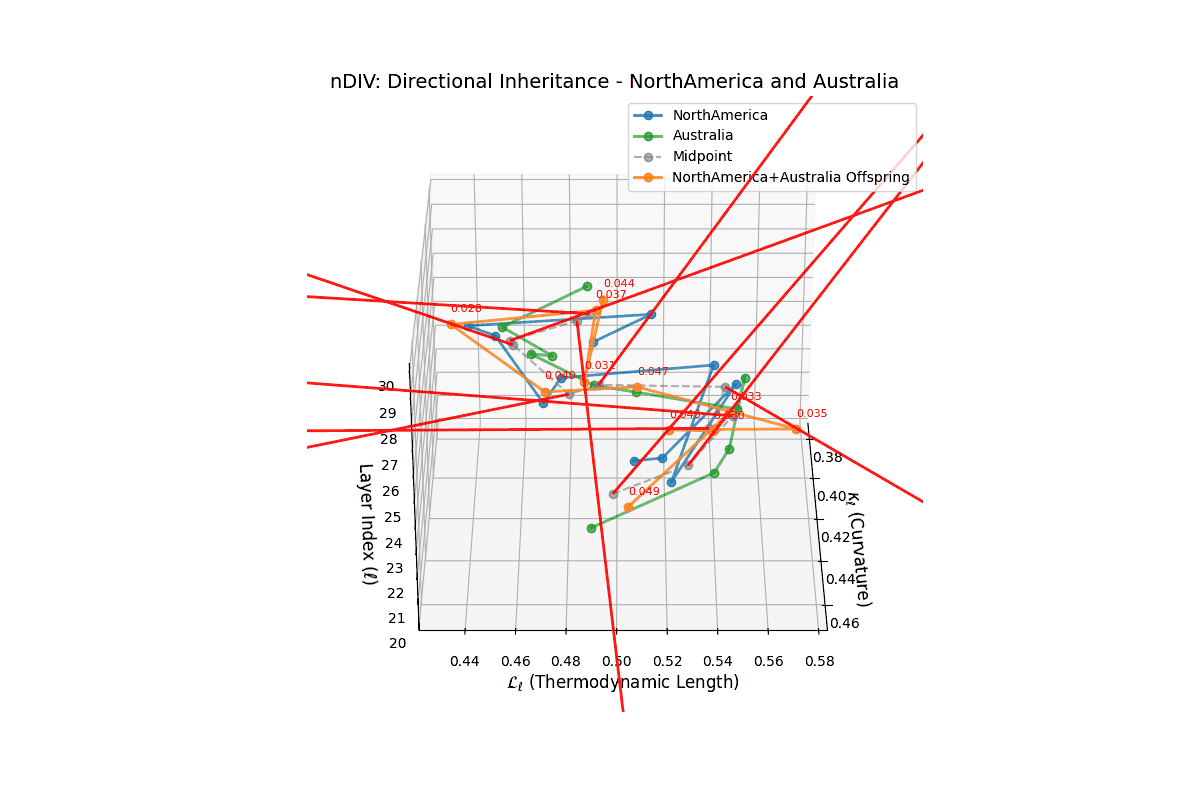
The offspring (orange) traces a semantic path over layers $\ell \in [20, 30]$, with curvature $\kappa_\ell \in [0.37, 0.47]$ and length $L_\ell \in [0.48, 0.58]$. Early layers align with North America (blue), mid to deeper layers blend in Australia’s (green) linguistic features. This transition reflects a controlled, layered fusion retaining conceptual foundations and integrating stylistic elements.
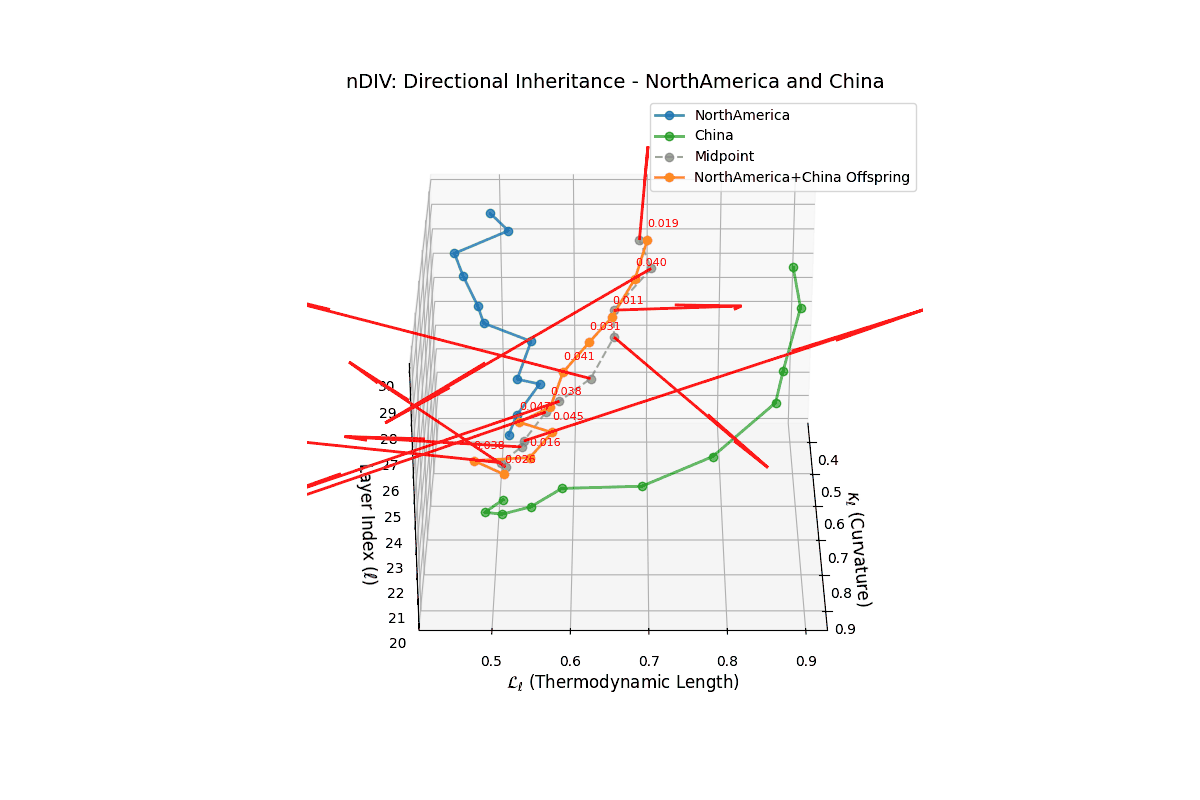
Across layers $\ell \in [20, 30]$, curvature $\kappa_\ell \in [0.38, 0.60]$ and length $L_\ell \in [0.43, 0.70]$, the offspring (orange) aligns with North America (blue), incorporating China’s (green) richness in deeper layers. This fusion preserves conceptual embeddings while reflecting cross-cultural adaptation, illustrating nuanced trade-offs in generation.
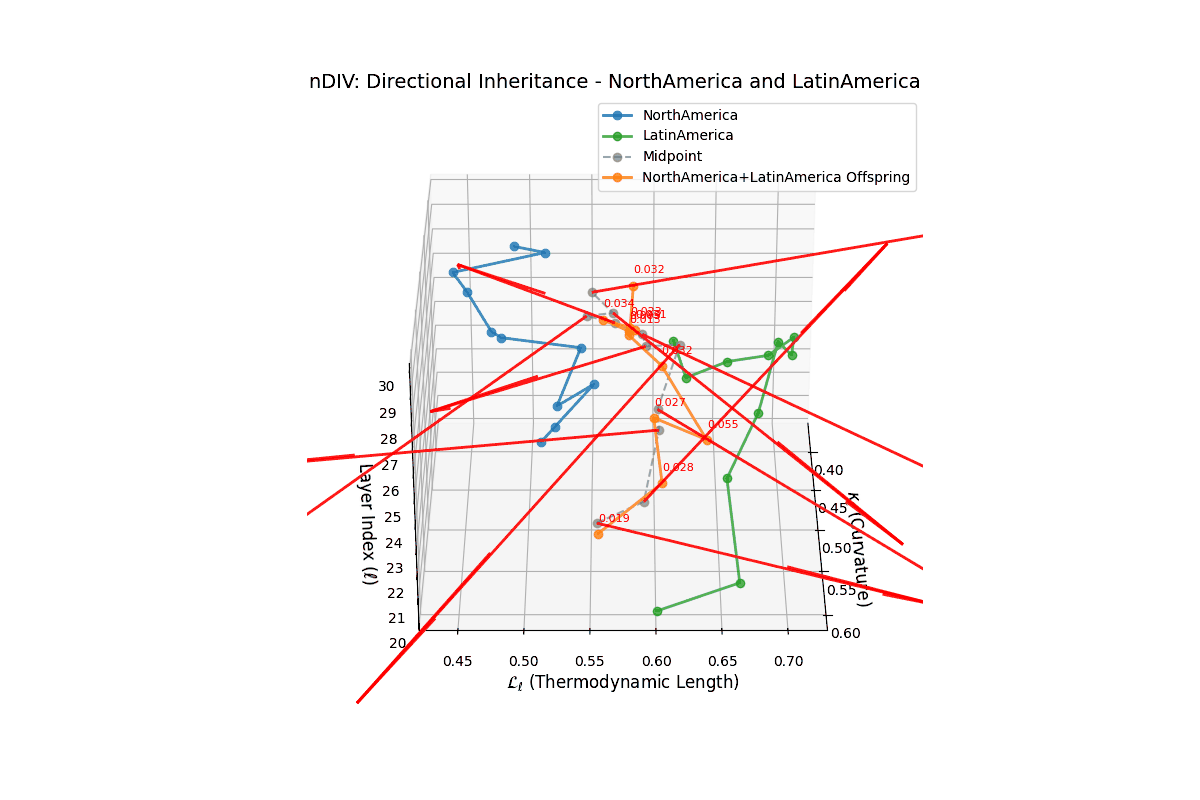
Over layers $\ell \in [20, 30]$, the offspring (orange) explores latent semantic space with $\kappa_\ell \in [0.40, 0.62]$ and $L_\ell \in [0.48, 0.70]$. Early layers align with North America (blue), shifting to Latin America (green) in deeper layers. This reveals a nuanced blending balancing conceptual preservation and cultural adaptation – controlled cross-cultural fusion.
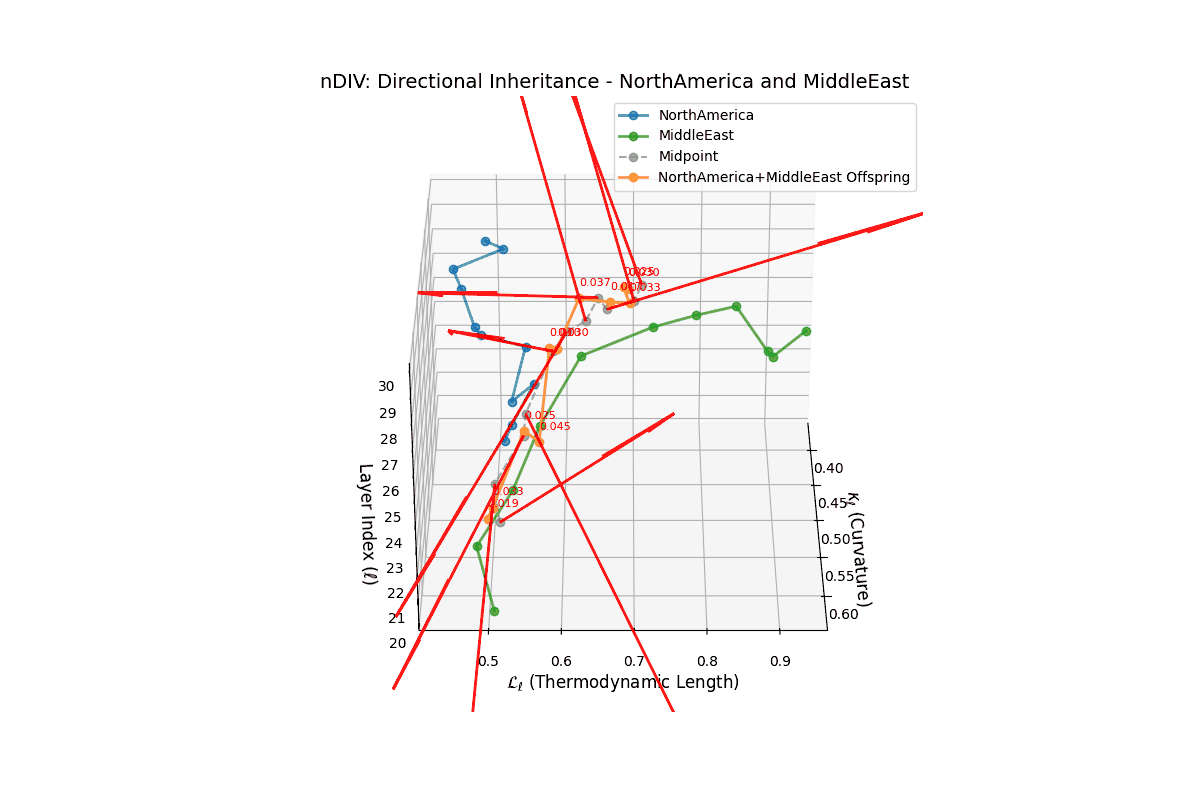
This 3D plot shows offspring semantic inheritance over layers $\ell \in [20, 30]$ with curvature $\kappa_\ell \in [0.40, 0.65]$ and length $L_\ell \in [0.45, 0.70]$. The offspring (orange) starts near North America (blue), then blends traits from Middle East (green) in deeper layers. This mosaic reflects dynamic conceptual preservation and regional adaptation.
Directional inheritance at layer \( \ell \) is given by:
\[ nDIV_{\text{dir}}^{(\ell)} = \cos \left( \overrightarrow{O}_{\ell} - \frac{\overrightarrow{P}^{(A)}_{\ell} + \overrightarrow{P}^{(B)}_{\ell}}{2} \; , \; \overrightarrow{P}^{(A)}_{\ell} - \overrightarrow{P}^{(B)}_{\ell} \right) \]
where \( \overrightarrow{P}^{(A)}_{\ell} \), \( \overrightarrow{P}^{(B)}_{\ell} \), and \( \overrightarrow{O}_{\ell} \) are the semantic vectors of the two parents and the offspring, respectively.
This parallels directional selection [5] and epigenetic regulation ([6];[18]), consistent with neural semantic evolution findings [19]. These insights enhance semantic fusion understanding, aiding targeted model alignment and inheritance control.
References
[1] Landry, Christian R, Hartl, Daniel L, and others “Genetic properties influencing the evolvability of gene expression” Science (2007).
[2] Gersen, Steven L and Keagle, Martha L “Clinical Cytogenetics” arXiv preprint (2012).
[3] Shapiro, Edward, Biezuner, Tamar, and others “Stem cell lineage tracing: techniques, applications and challenges” Nature Reviews Genetics (2013).
[4] Waddington, Conrad H “Canalization of development and the inheritance of acquired characters” Nature (1942).
[5] Endler, John A. “Natural Selection on Directional Traits” Annual Review of Ecology and Systematics (1986). https://doi.org/10.1146/annurev.es.17.110186.000443
[6] Jaenisch, Rudolf and Bird, Adrian “Epigenetic regulation of gene expression: how the genome integrates intrinsic and environmental signals” Nature Genetics (2003). https://www.nature.com/articles/ng1089
[7] Frank, Steven A “Natural selection. IV. The Price equation” Journal of Evolutionary Biology (2011).
[8] Hinton, Geoffrey “Neural networks for machine learning” Coursera lecture series (2012).
[9] Tenney, Ian, Das, Dipanjan, and others “BERT rediscovers the classical NLP pipeline” Proceedings of the 57th Annual Meeting of the Association for Computational Linguistics (2019).
[10] Alain, Guillaume and Bengio, Yoshua “Understanding intermediate layers using linear classifier probes” arXiv preprint arXiv:1610.01644 (2016). https://arxiv.org/abs/1610.01644
[11] Huang, Zhengyu and Sengupta, Anirvan “Cellular and molecular mechanisms of neural circuit development” Nature Reviews Neuroscience (2018).
[12] Saxena, Shweta and Cunningham, John P “Neural population dynamics during reaching” Nature (2019).
[13] Do Carmo, Manfredo Perdigao “Riemannian Geometry” arXiv preprint (1992).
[14] Arvanitidis, Georgios, Hansen, Lars K, and others “Geometric Manifold Learning in Neural Networks” Neural Networks ().
[15] Giusti, Alessandro, Citti, Giovanni, and others “Learning Geometric Structure in Manifolds” Neural Computation (2016).
[16] Amari, Shun-ichi “Natural gradient works efficiently in learning” Neural Computation (1998).
[17] Peyr{'e}, Gabriel and Cuturi, Marco “Computational Optimal Transport” Foundations and Trends® in Machine Learning (2019).
[18] Bird, Adrian “Perceptions of Epigenetics” Nature (2007).
[19] Bengio, Yoshua “Deep Learning of Representations: Looking Forward” Statistical Language and Speech Processing (2013).
